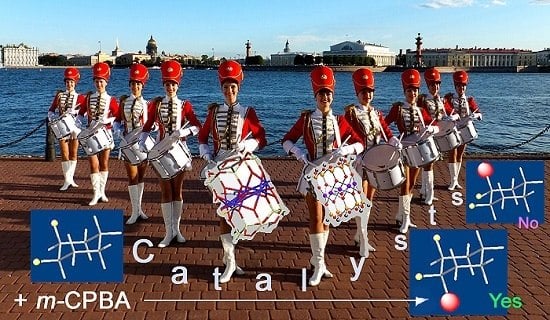New Trends in Oxidative Functionalization of Carbon–Hydrogen Bonds: A Review
Abstract
:1. Introduction
and wrote about“define CH activation as a facile CH cleavage reaction with an ‘MX’ species that proceeds by coordination of an alkane to the inner-sphere of ‘M’ (either via an intermediate ‘alkane complex’ or a transition state) leading to a M–C intermediate”[14]
Labinger and Bercaw gave the definition of“the CH activation reaction as a coordination reaction with a reactive species ‘M’, that proceeds without the involvement of free radicals, carbocations, or carbanions to generate discrete M–R intermediates”.
and Crabtree wrote:“reactions that have clearly been shown to involve bond formation between a metal and an alkane carbon”[18]
“Activation is considered to be the binding of a substrate to a metal center. This can be followed by a functionalization step in which the substrate is transformed...The term ‘CH activation’ emphasizes the distinct reactivity pattern of low valent metal complexes from that of classical organic reagents which break CH bonds by electrophilic or radical routes. In a classical route, radicals such as •OH readily abstract an H• atom from alkanes, RH, to give the alkyl radical R•. Included in this group are some metal catalyzed oxidations, such as the Gif reaction and Fenton chemistry”.[2]
2. Main Characteristics of Catalysts and Catalyzed Reactions
2.1. Definitions
Ionic liquids can be presented as examples [63,64,65,66].“To strengthen the relationship between catalysis and green chemistry, methods making use of neoteric solvents or alternative media rather than hazardous solvents, are more and more considered and represent unique challenges and opportunities for the future of catalysis”.[62]
2.2. Selectivity
2.3. Effect of Additives: Pyrazine-2-Carboxylic Acid (PCA)
3. New Catalysts and Ligands
3.1. Metal Ions Most Active in Oxidation Catalysis
3.2. New Types of Ligands and Catalysts
3.3. Polynuclear Metal Complexes As Catalysts
4. Mechanism of Oxidation by Peroxides: Radical, or not Radical, That is the Question
4.1. Detection and Determination of Alkyl Hydroperoxides Comparing GC before and after Treating Samples with PPh3
4.2. Competitive Oxidation of Alkane and Solvent
4.3. On the Rebound and Concerted Mechanisms
5. Some New Reactions
5.1. Shilov Chemistry
5.2. Periana System
5.3. Carboxylation of C–H Compounds (Sen-Fujiwara-Pombeiro Reaction)
“a hydrogen atom from methane and ethane to form the corresponding alkyl radicals which could be trapped efficiently by carbon monoxide, the resultant acyl radicals being ultimately converted into the homologous carboxylic acids”.[308]
6. Outlook
Acknowledgments
Conflicts of Interest
References
- Shilov, A.E.; Shul’pin, G.B. Activation and Catalytic Reactions of Saturated Hydrocarbons in the Presence of Metal Complexes; Kluwer Academic Publishers: New York, NY, USA; Boston, MA, USA; Dordrecht, Holland; London, UK; Moscow, Russia, 2002. [Google Scholar]
- Crabtree, R.H. Organomeallic alkane CH activation. J. Organomet. Chem. 2004, 689, 4083–4091. [Google Scholar] [CrossRef]
- Denisov, E.T.; Afanas’ev, I.B. Oxidation and Antioxidants in Organic Chemistry and Biochemistry; Taylor & Francis: Boca Raton, FL, USA; London, UK; New York, NY, USA; Singapore, 2005. [Google Scholar]
- Hartwig, J.F. Evolution of C–H bond functionalization from methane to methodokogy (Review). J. Am. Chem. Soc. 2016, 138, 2–24. [Google Scholar] [CrossRef] [PubMed]
- Davies, H.M.L.; Morton, D. Recent advances in C–H functionalization. J. Org. Chem. 2016, 81, 343–350. [Google Scholar] [CrossRef] [PubMed]
- Newhouse, T.; Baran, P.S. If C–H bonds could talk: Selective C–H bond oxidation. Angew. Chem. Int. Ed. 2011, 50, 3362–3374. [Google Scholar] [CrossRef] [PubMed]
- Zhou, M.; Crabtree, R.H. C–H Oxidation by platinum group metal oxo or peroxo species. Chem. Soc. Rev. 2011, 40, 1875–1884. [Google Scholar] [CrossRef] [PubMed]
- Webb, J.R.; Bolaño, T.; Gunnoe, B. Catalytic oxy-functionalization of methane and other hydrocarbons: Fundamental advancement and new strategies. ChemSusChem 2011, 4, 37–49. [Google Scholar] [CrossRef] [PubMed]
- Chepaikin, E.G. Homogeneous catalysis in the oxidative functionalization of alkanes in protic media. Russ. Chem. Rev. 2011, 80, 363–396. [Google Scholar] [CrossRef]
- Labinger, J.A.; Bercaw, J.E. The role of higher oxidation state species in platinum-mediated C–H bond activation and functionalization. Top. Organomet. Chem. 2011, 35, 29–60. [Google Scholar] [CrossRef]
- Shul’pin, G.B. Hydrocarbon oxygenations with peroxides catalyzed by metal compounds. Mini-Rev. Org. Chem. 2009, 6, 95–104. [Google Scholar] [CrossRef]
- Shul’pin, G.B. Selectivity enhancement in functionalization of C–H bonds: A review. Org. Biomol. Chem. 2010, 8, 4217–4228. [Google Scholar] [CrossRef] [PubMed]
- Shul’pin, G.B. C–H functionalization: Thoroughly tuning ligands at a metal ion, a chemist can greatly enhance catalyst’s activity and selectivity. Dalton Trans. 2013, 42, 12794–12818. [Google Scholar] [CrossRef] [PubMed]
- Periana, R.A.; Bhalla, G.; Tenn, W.J., III; Young, K.J.H.; Liu, X.Y.; Mironov, O.; Jones, C.J.; Ziatdinov, V.R. Perspectives on some challenges and approaches for developing the next generation of selective, low temperature, oxidation catalysts for alkane hydroxylation based on the CH activation reaction. J. Mol. Catal. A 2004, 220, 7–25. [Google Scholar] [CrossRef]
- Conley, B.L.; Ganesh, S.K.; Gonzales, J.M.; Ess, D.H.; Nielsen, R.J.; Ziatdinov, V.R.; Oxgaard, J.; Goddard, W.A., III; Periana, R.A. Facile oxy-functionalization of a nucleophilic metal alkyl with a cis- dioxo metal species via a (2+3) transition state. Angew. Chem. Int. Ed. 2008, 47, 7849–7852. [Google Scholar] [CrossRef] [PubMed]
- Bischof, S.M.; Ess, D.H.; Meier, S.K.; Oxgaard, J.; Nielsen, R.J.; Bhalla, G.; Goddard, W.A., III; Periana, R.A. Benzene C–H bond activation in carboxylic acids catalyzed by O-donor iridium(III) complexes: An experimental and density functional study. Organometallics 2010, 29, 742–756. [Google Scholar] [CrossRef]
- Hashiguchi, B.G.; Young, K.J.H.; Yousufuddin, M.; Goddard, W.A., III; Periana, R.A. Acceleration of nucleophilic CH activation by strongly basic solvents. J. Am. Chem. Soc. 2010, 132, 12542–12545. [Google Scholar] [CrossRef] [PubMed]
- Labinger, J.A.; Bercaw, J.E. Understanding and exploiting C–H bond activation. Nature 2002, 417, 507–514. [Google Scholar] [CrossRef] [PubMed]
- Munz, D.; Webster-Gardiner, M.; Fu, R.; Strassner, T.; Goddard, W.A., III; Gunnoe, T.B. Proton or metal? The H/D exchange of arenes in acidic solvents. ACS Catal. 2015, 5, 769–775. [Google Scholar] [CrossRef]
- Burton, S.G. Oxidizing enzymes as biocatalysts. Trends Biotechnol. 2003, 21, 543–549. [Google Scholar] [CrossRef] [PubMed]
- Coon, M.J. Omega oxygenases: Nonheme-iron enzymes and P450 cytochromes. Biochem. Biophys. Res. Commun. 2005, 338, 378–385. [Google Scholar] [CrossRef] [PubMed]
- Stone, K.L.; Borovik, A.S. Lessons from nature: Unraveling biological C–H bond activation. Curr. Opin. Chem. Biol. 2009, 13, 114–118. [Google Scholar] [CrossRef] [PubMed]
- Austin, R.N.; Groves, J.T. Alkane-oxidizing metalloenzymes in the carbon cycle. Metallomics 2011, 3, 775–787. [Google Scholar] [CrossRef] [PubMed]
- Yang, G.; Ding, Y. Recent advances in biocatalyst discovery, development and applications. Bioorg. Med. Chem. 2014, 22, 5604–5612. [Google Scholar] [CrossRef] [PubMed]
- Matsuo, T.; Hirota, S. Artificial enzymes with protein scaffolds: Structural design and modification. Bioorg. Med. Chem. 2014, 22, 5638–5656. [Google Scholar] [CrossRef] [PubMed]
- Doble, M.V.; Ward, A.C.C.; Deuss, P.J.; Jarvis, A.G.; Kamer, P.C.J. Catalyst design in oxidation chemistry; from KMnO4 to artificial metalloenzymes. Bioorg. Med. Chem. 2014, 22, 5657–5677. [Google Scholar] [CrossRef] [PubMed]
- Blomberg, M.R.A.; Borowsky, T.; Himo, F.; Liao, R.-Z.; Siegbahn, P.E.M. Quantum chemical studies of mechanisms for metalloenzymes. Chem. Rev. 2014, 114, 3601–3658. [Google Scholar] [CrossRef] [PubMed]
- Poulos, T.L. Heme enzyme structure and function. Chem. Rev. 2014, 114, 3919–3962. [Google Scholar] [CrossRef] [PubMed]
- Zhuk, T.S.; Goldman, M.; Hofmann, J.; Pohl, J.C.S.; Zorn, H. Preparative aerobic oxidations with basidiomycetous enzymes: CH-functionalization of adamantane. J. Mol. Catal. B 2015, 122, 87–92. [Google Scholar] [CrossRef]
- Ishii, Y.; Sakaguchi, S. Recent progress in aerobic oxidation of hydrocarbons by N-hydroxyimides. Catal. Today 2006, 117, 105–113. [Google Scholar] [CrossRef]
- Vastin, B.A.; Hall, M.B. The molecular and electronic structure of carbon–hydrogen bond activation and transition metal assisited hydrogen transfer. Coord. Chem. Rev. 2009, 253, 1202–1218. [Google Scholar] [CrossRef]
- Gunay, A.; Theopold, H.H. C–H bond activations by metal oxo compounds. Chem. Rev. 2010, 110, 1060–1081. [Google Scholar] [CrossRef] [PubMed]
- Chepaikin, E.G. Oxidative functionalization of alkanes under dioxygen in the presenceof homogeneous noble metal catalysts. J. Mol. Catal. A 2014, 385, 160–174. [Google Scholar] [CrossRef]
- Alkane C‒H Activation by Single-Site Metal Catalysis; Pérez, P.J. (Ed.) Springer: Heidelberg, Germany, 2012.
- Cavaliere, V.N.; Mindiola, D.J. Methane: A new frontier in organometallic chemistry. Chem. Sci. 2012, 3, 3356–3365. [Google Scholar] [CrossRef]
- Campbell, A.N.; Stahl, S.S. Overcoming the “Oxidant Problem”: Strategies to use O2 as the oxidant in organometallic C–H oxidation reactions catalysed by Pd (and Cu). Acc. Chem. Res. 2012, 45, 851–863. [Google Scholar] [CrossRef] [PubMed]
- Hartwig, J.F. Borylation and silylation of C–H bonds: A platform for diverse C–H bond functionalizations. Acc. Chem. Res. 2012, 45, 864–873. [Google Scholar] [CrossRef] [PubMed]
- Hashiguchi, B.G.; Bischof, S.M.; Konnick, M.M.; Periana, R.A. Designing catalysts for functionalization of unactivated C–H bonds based on the CH activation reaction. Acc. Chem. Res. 2012, 45, 885–898. [Google Scholar] [CrossRef] [PubMed]
- Roizen, J.L.; Harvey, M.E.; Du Bois, J. Metal-catalyzed nitrogen-atom transfer methods for the oxidation of aliphatic C–H bonds. Acc. Chem. Res. 2012, 45, 911–922. [Google Scholar] [CrossRef] [PubMed]
- Sivaramakrishna, A.; Suman, P.; Goud, E.V.; Janardan, S.; Sravani, C.; Sandep, T.; Vijayakrishna, K.; Clayton, H.S. Review: Active homogeneous reagents and catalysts in n-alkane activation reactions. J. Coord. Chem. 2013, 66, 2091–2109. [Google Scholar] [CrossRef]
- Caballero, A.; Pérez, P.J. Methane as raw material in synthetic chemistry: The final frontier. Chem. Soc. Rev. 2013, 42, 8809–8820. [Google Scholar] [CrossRef] [PubMed]
- Sun, M.; Zhang, J.; Putaj, P.; Caps, V.; Lefebre, F.; Pelletier, J.; Basset, J.-M. Catalytic oxidation of light alkanes (C1-C4) by heteropoly compounds. Chem. Rev. 2014, 114, 981–1019. [Google Scholar] [CrossRef] [PubMed]
- Hussain, I.; Singh, T. Synthesis of biaryls through aromatic C–H bond activation: A review of recent developments. Adv. Synth. Catal. 2014, 356, 1661–1696. [Google Scholar] [CrossRef]
- Guan, W.; Sayyed, F.B.; Zeng, G.; Sakaki, S. σ-Bond activation of small molecules and reactions catalyzed by transition-metal complexes: Theoretical understanding of electronic processes. Inorg. Chem. 2014, 53, 6444–6457. [Google Scholar] [CrossRef] [PubMed]
- Landaeta, V.R.; Rodríguez-Lugo, R.E. Catalytic oxygenation of organic substrates: Toward greener ways for incorporating oxygen. Inorg. Chim. Acta 2015, 431, 21–47. [Google Scholar] [CrossRef]
- Horn, R.; Schlogl, R. Methane activation by heterogeneous catalysis. Catal. Lett. 2015, 145, 23–39. [Google Scholar] [CrossRef]
- Souillart, L.; Cramer, N. Catalytic C–C bond activation via oxidative addition to transition metals. Chem. Rev. 2015, 115, 9410–9464. [Google Scholar] [CrossRef] [PubMed]
- Kuninobu, Y.; Sueki, S. C–H Bond transformations leading to the synthesis of organic functional materials. Synthesis 2015, 47, 3823–3845. [Google Scholar] [CrossRef]
- Reay, A.J.; Fairlamb, J.S. Catalytic C–H bond functionalisation chemistry: The case for quasi-heterogeneous catalysis. Chem. Commun. 2015, 51, 16289–16307. [Google Scholar] [CrossRef] [PubMed]
- Chepaikin, E.G.; Borsch, V.N. Rhodium complexes in homogeneous catalytic systems for oxidative functionalization of alkanes: Experiment and quantum-chemical calculations. J. Organomet. Chem. 2015, 793, 78–82. [Google Scholar] [CrossRef]
- Munz, D.; Strassner, T. Alkane C–H functionalization and oxidation with molecular oxygen. Inorg. Chem. 2015, 54, 5043–5052. [Google Scholar] [CrossRef] [PubMed]
- Khan, M.S.; Haque, A.; Al-Suti, M.K.; Raithby, P.R. Recent advances in the application of group-10 transition metal based catalysts in C–H activation and functionalization. J. Organomet. Chem. 2015, 793, 114–133. [Google Scholar] [CrossRef]
- van Leeuwen, P.W.N.M.; Chadwick, J.C. Homogeneous Catalysis: Activity, Stability and Deactivation; Wiley: Weinheim, Germany, 2011. [Google Scholar]
- Kozuch, S.; Shaik, S. How to conceptualize catalytic cycles? The energetic span model. Acc. Chem. Res. 2011, 44, 101–110. [Google Scholar] [CrossRef] [PubMed]
- Kozuch, S.; Martin, J.M.L. “Turning over” definitions in catalytic cycles. ACS Catal. 2012, 2, 2787–2794. [Google Scholar] [CrossRef]
- Kirillova, M.V.; Da Silva, J.A.L.; Fraústo da Silva, J.J.R.; Pombeiro, A.J.L. Direct and efficient transformation of gaseous alkanes into carboxylic acids catalyzed by vanadium containing heteropolyacids. Appl. Catal. A 2007, 332, 159–165. [Google Scholar] [CrossRef]
- Shul’pin, G.B.; Kirillova, M.V.; Kozlov, Y.N.; Shul’pina, L.S.; Kudinov, A.R.; Pombeiro, A.J.L. Decamethylosmocene-catalyzed efficient oxidation of saturated and aromatic hydrocarbons and alcohols with hydrogen peroxide in the presence of pyridine. Part 3 from the series “Oxidations Catalyzed by Osmium Compounds”. J. Catal. 2011, 277, 164–172. [Google Scholar] [CrossRef]
- Shul’pin, G.B.; Nizova, G.V.; Kozlov, Y.N.; Arutyunov, V.S.; dos Santos, A.C.M.; Ferreira, A.C.T.; Mandelli, D. Oxidations by the system “hydrogen peroxide–[Mn2L2O3][PF6]2 (L = 1,4,7-trimethyl-1,4,7-triazacyclononane)–oxalic acid.” Part 6. Oxidation of methane and other alkanes and olefins in water. J. Organomet. Chem. 2005, 690, 4498–4504. [Google Scholar] [CrossRef]
- Sorokin, A.B.; Kudrik, E.V.; Alvarez, L.X.; Afanasiev, P.; Millet, J.M.M.; Bouchu, D. Oxidation of methane and ethylene in water at ambient conditions. Catal. Today 2010, 157, 149–154. [Google Scholar] [CrossRef]
- Shul’pin, G.B.; Druzhinina, A.N. Iron(III) chloride catalysed photooxygenation of alcohol solutions of alkanes by atmospheric oxygen. Mendeleev Commun. 1992, 2, 36–37. [Google Scholar] [CrossRef]
- Shul’pin, G.B.; Nizova, G.V.; Kozlov, Y.N. Photochemical aerobic oxidation of alkanes promoted by iron complexes. Part 32 of the series “Photoinduced Reactions of Organic Compounds with Metal Complexes”. New J. Chem. 1996, 20, 1243–1256. [Google Scholar]
- Lamaty, F.; Dupont, J. Preface to the special issue on “Catalysis in neoteric solvent or alternative media”. Catal. Commun. 2015, 63, 1. [Google Scholar] [CrossRef]
- Jlassi, R.; Ribeiro, A.P.C.; Guedes da Silva, M.F.C.; Mahmudov, K.T.; Kopylovich, M.N.; Anisimova, T.B.; Pombeiro, A.J.L. Polynuclear copper(II) complexes as catalysts for the peroxidative oxidation of cyclohexane in a room-temperature ionic liquid. Eur. J. Inorg. Chem. 2014, 4541–4550. [Google Scholar] [CrossRef]
- Chepaikin, E.G.; Bezruchenko, A.P.; Menchikova, G.N.; Moiseeva, N.I.; Gekhman, A.E. Direct catalytic oxidation of lower alkanes in ionic liquid media. Petrol. Chem. 2014, 54, 374–381. [Google Scholar] [CrossRef]
- Lentini, S.; Galloni, P.; Garcia-Bosch, I.; Costas, M.; Conte, V. Ionic liquids as reaction media in catalytic oxidations with manganese and iron pyridyl triazacyclononane complexes. Inorg. Chim. Acta 2014, 410, 60–64. [Google Scholar] [CrossRef]
- Ribeiro, A.P.C.; Martins, L.M.D.R.S.; Hazra, S.; Pombeiro, A.J.L. Catalytic oxidation of cyclohexane with hydrogen peroxide and a tetracopper(II) complex in an ionic liquid. C. R. Chim. 2015, 18, 758–765. [Google Scholar] [CrossRef]
- Zhang, Y.; Zhang, N.; Tang, Z.-R.; Xu, Y.-J. Transforming CdS into an efficient visible light photocatalyst for selective oxidation of saturated primary C–H bonds under ambient conditions. Chem. Sci. 2012, 3, 2812–2822. [Google Scholar] [CrossRef]
- Ohtani, B. Titania photocatalysis beyond recombination: A critical review. Catalysts 2013, 3, 942–953. [Google Scholar] [CrossRef]
- Vaiano, V.; Sannino, D.; Almeida, A.R.; Mul, G.; Ciambelli, P. Investigation of the deactivation phenomena occurring in the cyclohexane photocatalytic oxidative dehydrogenation on MoOx/TiO2 through gas phase and in situ DRIFTS analyses. Catalysts 2013, 3, 978–997. [Google Scholar] [CrossRef]
- Hoffmann, N. Combining photoredox and metal catalysis. ChemCatChem 2015, 7, 393–394. [Google Scholar] [CrossRef]
- Protti, S.; Fagnoni, M.; Ravelli, D. Photocatalytic C–H activation by hydrogen-atom transfer in synthesis. ChemCatChem 2015, 7, 1516–1523. [Google Scholar] [CrossRef]
- Liu, Y.; Chen, L.; Yuan, Q.; He, J.; Au, C.-T.; Yin, S.-F. A green and efficient photocatalytic route for the highly-selective oxidation of saturated alpha-carbon C–H bonds in aromatic alkanes over flower-like Bi2WO6. Chem. Commun. 2016, 52, 1274–1277. [Google Scholar] [CrossRef] [PubMed]
- Bermudez, J.M.; Menendez, J.A.; Arenillas, A.; Martínez-Palou, R.; Antonio, A.; Romero, A.A.; Luque, R. Graphene oxide-catalysed oxidation reaction of unsaturated compounds under microwave irradiation. Catal. Commun. 2015, 72, 133–137. [Google Scholar] [CrossRef]
- Joglekar, M.; Nguyen, V.; Pylypenko, S.; Ngo, C.; Li, Q.; O’Reilly, M.E.; Gray, T.S.; Hubbard, W.A.; Gunnoe, T.B.; Herring, A.M.; Trewyn, B.G. Organometallic complexes anchored to conductive carbon for electrocatalytic oxidation of methane at low temperature. J. Am. Chem. Soc. 2016, 216, 116–125. [Google Scholar]
- Cravotto, G.; Borretto, E.; Oliverio, M.; Procopio, A.; Penoni, A. Organic reactions in water or biphasic aqueous systems under sonochemical conditions. A review on catalytic effects. Catal. Commun. 2015, 63, 2–9. [Google Scholar] [CrossRef]
- Garner, A.W.; Harris, C.F.; Vezzu, D.A.K.; Pike, R.D.; Huo, S. Solvent-controlled switch of selectivity between sp2 and sp3 C–H bond activation by platinum(II). Chem. Commun. 2011, 47, 1902–1904. [Google Scholar] [CrossRef] [PubMed]
- Shul’pin, G.B.; Nizova, G.V. Selective photochemical ketonization of cyclohexane by air in aqueous emulsion in the presence of iron ions. Mendeleev Commun. 1995, 143–145. [Google Scholar] [CrossRef]
- Shul’pin, G.B.; Attanasio, D.; Suber, L. Efficient H2O2 oxidation of alkanes and arenes to alkyl peroxides and phenols catalyzed by the system vanadate-pyrazine-2-carboxylic acid. J. Catal. 1993, 142, 147–152. [Google Scholar] [CrossRef]
- Shul’pin, G.B.; Attanasio, D.; Suber, L. Oxidations by a H2O2-VO3−-pyrazine-2-carboxylic acid reagent. 1. Oxidations of alkanes in CH3CN to produce alkyl peroxides. Russ. Chem. Bull. 1993, 42, 55–59. [Google Scholar] [CrossRef]
- Nizova, G.V.; Shul’pin, G.B. Oxidation by a H2O2-vanadium complex-2-pyrazinecarboxylic acid reagent. 3. Evidence for hydroxyl radical formation. Russ. Chem. Bull. 1994, 43, 1146–1148. [Google Scholar] [CrossRef]
- Shul’pin, G.B.; Drago, R.S.; Gonzalez, M. Oxidations by a “H2O2-vanadium complex–pyrazine-2-carboxylic acid” reagent. 5. Oxidation of lower alkanes with the formation of carbonyl compounds. Russ. Chem. Bull. 1996, 45, 2386–2388. [Google Scholar]
- Shul’pin, G.B.; Guerreiro, M.C.; Schuchardt, U. Oxidations by the reagent O2-H2O2-vanadium complex-pyrazine-2-carboxylic acid. Part 7. Hydroperoxidation of higher alkanes. Tetrahedron 1996, 52, 13051–13062. [Google Scholar] [CrossRef]
- Nizova, G.V.; Süss-Fink, G.; Shul’pin, G.B. Oxidations by the reagent «O2-H2O2-vanadium complex-pyrazine-2-carboxylic acid»-8. Efficient oxygenation of methane and other lower alkanes in acetonitrile. Tetrahedron 1997, 53, 3603–3614. [Google Scholar] [CrossRef]
- Shul’pin, G.B.; Ishii, Y.; Sakaguchi, S.; Iwahama, T. Oxidations with the “O2-H2O2-vanadium complex-pyrazine-2-carboxylic acid” reagent. 11. Oxidation of styrene, phenylacetylene, and their derivatives with the formation of benzaldehyde and benzoic acid. Russ. Chem. Bull. 1999, 48, 887–890. [Google Scholar] [CrossRef]
- Shul’pin, G.B.; Kozlov, Y.N.; Nizova, G.V.; Süss-Fink, G.; Stanislas, S.; Kitaygorodskiy, A.; Kulikova, V.S. Oxidations by the reagent "O2-H2O2-vanadium derivative–pyrazine-2-carboxylic acid" Part 12. Main features, kinetics and mechanism of alkane hydroperoxidation. J. Chem. Soc. Perkin Trans. 2001, 2, 1351–1371. [Google Scholar]
- De la Cruz, M.H.C.; Kozlov, Y.N.; Lachter, E.R.; Shul’pin, G.B. Oxidations by the reagent “O2-H2O2-vanadium derivative-pyrazine-2-carboxylic acid.” Part 13. Kinetics and mechanism of the benzene hydroxylation. New J. Chem. 2003, 27, 634–638. [Google Scholar] [CrossRef]
- Khaliullin, R.Z.; Bell, A.T.; Head-Gordon, M. A density functional theory study of the mechanism of free radical generation in the system vanadate/PCA/H2O2. J. Phys. Chem. B 2005, 109, 17984–17992. [Google Scholar] [CrossRef] [PubMed]
- Kozlov, Y.N.; Romakh, V.B.; Kitaygorodskiy, A.; Buglyó, P.; Süss-Fink, G.; Shul’pin, G.B. Oxidation of 2-propanol and cyclohexane by the reagent “Hydrogen peroxide-vanadate anion-pyrazine-2-carboxylic acid”: Kinetics and mechanism. J. Phys. Chem. A 2007, 111, 7736–7752. [Google Scholar] [CrossRef] [PubMed]
- Romakh, V.B.; Süss-Fink, G.; Shul’pin, G.B. Vanadate ion-catalyzed oxidation of methane with hydrogen peroxide in an aqueous solution. Petrol. Chem. 2008, 48, 440–443. [Google Scholar] [CrossRef]
- Kirillova, M.V.; Kuznetsov, M.L.; Romakh, V.B.; Shul’pina, L.S.; Fraústo da Silva, J.J.R.; Pombeiro, A.J.L.; Shul’pin, G.B. Mechanism of oxidations with H2O2 catalyzed by vanadate anion or oxovanadium(V) triethanolaminate (vanadatrane) in combination with pyrazine-2-carboxylic acid (PCA): Kinetic and DFT studies. J. Catal. 2009, 267, 140–157. [Google Scholar] [CrossRef]
- Gusevskaya, E.V.; Menini, L.; Parreira, L.A.; Mesquita, R.A.; Kozlov, Y.N.; Shul’pin, G.B. Oxidation of isoeugenol to vanillin by the “H2O2-vanadate-pyrazine-2-carboxylic acid” reagent. J. Mol. Catal. A 2012, 363–364, 140–147. [Google Scholar] [CrossRef]
- Sutradhar, M.; Shvydkiy, N.V.; da Silva, M.F.C.G.; Kirillova, M.V.; Kozlov, Y.N.; Pombeiro, A.J.L.; Shul’pin, G.B. New binuclear oxovanadium(V) complex as a catalyst in combination with pyrazinecarboxylic acid (PCA) for efficient alkane oxygenation by H2O2. Dalton Trans. 2013, 42, 11791–11803. [Google Scholar] [CrossRef] [PubMed]
- Nizova, G.V.; Krebs, B.; Süss-Fink, G.; Schindler, S.; Westerheide, L.; Gonzalez Cuervo, L.; Shul’pin, G.B. Hydroperoxidation of methane and other alkanes with H2O2 catalysed by a dinuclear iron complex and an amino acid. Tetrahedron 2002, 58, 9231–9237. [Google Scholar] [CrossRef]
- Shul’pin, G.B.; Nizova, G.V.; Kozlov, Y.N.; Gonzalez Cuervo, L.; Süss-Fink, G. Hydrogen peroxide oxygenation of alkanes including methane and ethane catalyzed by iron complexes in acetonitrile. Adv. Synth. Catal. 2004, 346, 317–332. [Google Scholar] [CrossRef]
- Romakh, V.B.; Therrien, B.; Süss-Fink, G.; Shul’pin, G.B. Synthesis, molecular structure and catalytic potential of the tetrairon complex [Fe4(N3O2-L)4(μ-O)2]4+ (L = 1-carboxymethyl-4,7-dimethyl-1,4,7-triazacyclononane). Inorg. Chem. 2007, 46, 3166–3175. [Google Scholar] [CrossRef] [PubMed]
- Shul’pina, L.S.; Kudinov, A.R.; Mandelli, D.; Carvalho, W.A.; Kozlov, Y.N.; Vinogradov, M.M.; Ikonnikov, N.S.; Shul’pin, G.B. Oxidation of alkanes and benzene with hydrogen peroxide catalyzed by ferrocene in the presence of acids. J. Organomet. Chem. 2015, 793, 217–231. [Google Scholar] [CrossRef]
- Nizova, G.V.; Shul’pin, G.B. A unique rate-accelerating effect of certain amino acids in the H2O2 oxidation of alkanes catalyzed by a dinuclear manganese complex containing 1,4,7-trimethyl-1,4,7-triazacyclononane. Part 9 from the series “Oxidations by the system ‘hydrogen peroxide–[Mn2L2O3][PF6]2 (L =1,4,7-trimethyl-1,4,7-triazacyclononane)–carboxylic acid”. Tetrahedron 2007, 63, 7997–8001. [Google Scholar]
- Shul’pin, G.B.; Matthes, M.G.; Romakh, V.B.; Barbosa, M.I.F.; Aoyagi, J.L.T.; Mandelli, D. Oxidations by the system “hydrogen peroxide–[Mn2L2O3][PF6]2 (L = 1,4,7-trimethyl-1,4,7-triazacyclononane)–carboxylic acid.” Part 10: Co-catalytic effect of different carboxylic acids in the oxidation of cyclohexane, cyclohexanol, and acetone. Tetrahedron 2008, 64, 2143–2152. [Google Scholar] [CrossRef]
- Schuchardt, U.; Mandelli, D.; Shul’pin, G.B. Methyltrioxorhenium catalyzed oxidation of saturated and aromatic hydrocarbons by H2O2 in air. Tetrahedron Lett. 1996, 37, 6487–6490. [Google Scholar] [CrossRef]
- Karslyan, E.E.; Shul’pina, L.S.; Kozlov, Y.N.; Pombeiro, A.J.L.; Shul’pin, G.B. Oxygenation of saturated and aromatic hydrocarbons with H2O2 catalyzed by the carbonyl thiophenolate iron complex (OC)3Fe(PhS)2Fe(CO)3. Catal. Today 2013, 218–219, 93–98. [Google Scholar] [CrossRef]
- Fernandes, R.R.; Kirillova, M.V.; da Silva, J.A.L.; Fraústo da Silva, J.J.R.; Pombeiro, A.J.L. Oxidations of cycloalkanes and benzene by hydrogen peroxide catalyzed by an {FeIIIN2S2} centre. Appl. Catal. A 2009, 353, 107–112. [Google Scholar] [CrossRef]
- Fernandes, R.R.; Lasri, J.; Guedes da Silva, M.F.C.; da Silva, J.A.L.; Fraústo da Silva, J.J.R.; Pombeiro, A.J.L. Mild alkane C–H and O-H oxidations catalysed by mixed-N,S copper, iron and vanadium systems. Appl. Catal. A 2011, 402, 110–120. [Google Scholar] [CrossRef]
- Milunovic, M.N.M.; Martins, L.M.D.R.S.; Alegria, E.C.B.A.; Pombeiro, A.J.L.; Krachler, R.; Trettenhahn, G.; Turta, C.; Shova, S.; Arion, V.B. Hexanuclear and undecanuclear iron(III) carboxylates as catalyst precursors for cyclohexane oxidation. Dalton Trans. 2013, 40, 14388–14401. [Google Scholar] [CrossRef] [PubMed][Green Version]
- Carabineiro, S.A.C.; Martins, L.M.D.R.S.; Avalos-Borja, M.; Buijnsterse, J.G.; Pombeiro, A.J.L.; Figueiredo, J.L. Gold nanoparticles supported on carbon materials for cyclohexane oxidation with hydrogen peroxide. Appl. Catal. A 2013, 467, 279–290. [Google Scholar] [CrossRef]
- Kirillov, A.M.; Shul’pin, G.B. Pyrazinecarboxylic acid and analogs: Highly efficient co-catalysts in the metal-complex-catalyzed oxidation of organic compounds. Coord. Chem. Rev. 2013, 257, 732–754. [Google Scholar] [CrossRef]
- Kirillova, M.V.; Kirillov, A.M. 2-Pyrazinecarboxylic Acid. In Encyclopedia of Reagents for Organic Synthesis; Fuchs, P.L., Ed.; Wiley: Chichester, UK.
- Piquemal, J.-Y.; Briot, E.; Brégeault, J.-M. Preparation of materials in the presence of hydrogen peroxide: From discrete or “zero-dimensional” objects to bulk materials. Dalton Trans. 2013, 42, 29–45. [Google Scholar] [CrossRef] [PubMed]
- Khenkin, A.M.; Neumann, R. Carbon–hydrogen bond activation of arenes and alkylarenes by electron transfer followed by oxygen transfer catalyzed by vanadium substituted polyoxometalates—A comparative study of the reactivity of different polyoxometalate compounds. J. Organomet. Chem. 2015, 793, 134–138. [Google Scholar] [CrossRef]
- Zalomaeva, O.V.; Evtushok, V.Y.; Maksimov, G.M.; Kholdeeva, O.A. Selective oxidation of pseudocumene and 2-methylnaphthalene with aqueous hydrogen peroxide catalyzed by Keggin divanadium-substituted polyoxotungstate. J. Organomet. Chem. 2015, 793, 210–216. [Google Scholar] [CrossRef]
- Jing, F.; Katryniok, B.; Bordes-Richard, E.; Dumeignil, F.; Paul, S. Structural evolution under reaction conditions of supported (NH4)3HPMo11VO40 catalysts for the selective oxidation of isobutane. Catalysts 2015, 5, 460–477. [Google Scholar] [CrossRef]
- Alberto, J.; Garcia, H. Doped graphenes in catalysis. J. Mol. Catal. A 2015, 408, 296–309. [Google Scholar] [CrossRef]
- Gruselle, M. Apatites: A new family of catalysts in organic synthesis. J. Organomet. Chem. 2015, 793, 93–101. [Google Scholar] [CrossRef]
- Rahman, A.K.M.L.; Kumashiro, M.; Ishihara, T. Direct synthesis of formic acid by partial oxidation of methane on H-ZSM-5 solid acid catalyst. Catal. Commun. 2011, 12, 1198–1200. [Google Scholar] [CrossRef]
- Wannakao, S.; Warakulwit, C.; Kongpatpanich, K.; Probst, M.; Limtrakul, J. Methane activation in gold cation-exchanged zeolites: A DFT study. ACS Catal. 2012, 2, 986–992. [Google Scholar] [CrossRef]
- Forde, M.M.; Armstrong, R.D.; Hammond, C.; He, Q.; Jenkins, R.L.; Kondrat, S.A.; Dimitratos, N.; Lopez-Sanchez, J.A.; Tylor, S.H.; Willock, D.; et al. Partial oxidation of ethane to oxygenates using Fe- and Cu-containing ZSM-5. J. Am. Chem. Soc. 2013, 135, 11087–11099. [Google Scholar] [CrossRef] [PubMed]
- Liquid Phase Oxidation via Heterogeneous Catalysis; Clerici, M.G.; Kholdeeva, O.A. (Eds.) Wiley: Hoboken, NJ, USA, 2013.
- Kholdeeva, O.A.; Skobelev, I.Y.; Ivanchikova, I.D.; Kovalenko, K.A.; Fedin., V.P.; Sorokin, A.B. Hydrocarbon oxidation over Fe- and Cr-containing metal-organic frameworks MIL-100 and MIL-101—A comparative study. Catal. Today 2014, 238, 54–61. [Google Scholar] [CrossRef]
- Kholdeeva, O.A. Recent developments in liquid-phase selective oxidation using environmentally benign oxidants and mesoporous metal silicates. Catal. Sci. Technol. 2014, 4, 1869–1889. [Google Scholar] [CrossRef]
- Alayon, E.M.C.; Nachtegaal, M.; Bodi, A.; Rabocchiari, M.; van Bokhoven, J.A. Bis(mu-oxo) versus mono(mu-oxo)dicopper cores in a zeolite for converting methane to methanol: An in situ XAS and DFT investigation. Phys. Chem. Chem. Phys. 2015, 17, 7681–7693. [Google Scholar] [CrossRef] [PubMed]
- Zou, H.; Sun, Q.; Fan, D.; Fu, W.; Liu, L.; Wang, R. Facile synthesis of Yolk/Core-Shell structured TS-1@Mesosilica composites for enhanced hydroxylation of phenol. Catalysts 2015, 5, 2134–2146. [Google Scholar] [CrossRef]
- Dragomirova, R.; Wohlrab, S. Zeolite membranes in catalysis—From separate units to particle coatings. Catalysts 2015, 5, 2161–2222. [Google Scholar] [CrossRef]
- Hammond, C.; Hermans, I.; Dimitratos, N. Biomimetic oxidation with Fe-ZSM-5 and H2O2? Identification of an active, extra-framework binuclear core and an FeIII-OOH intermediate with resonance-enhanced Raman spectroscopy. ChemCatChem 2015, 7, 434–440. [Google Scholar] [CrossRef]
- Xie, J.; Pan, C.; Abdukader, A.; Zhu, C. Gold-catalyzed C(sp3)–H bond functionalization. Chem. Soc. Rev. 2014, 43, 5245–5256. [Google Scholar] [CrossRef] [PubMed]
- Strassner, T.; Ahrens, S.; Muehlhofer, M.; Munz, D.; Zeller, A. Cobalt-catalyzed oxidation of methane to methyl trifluoroacetate by dioxygen. Eur. J. Inorg. Chem. 2013, 3659–3663. [Google Scholar] [CrossRef]
- Bellows, S.M.; Thomas, R.; Cundari, T.R.; Jones, W.D. Methane is the best substrate for C(sp3)−H activation with Cp*(PMe3)Co(Me)(OTf): A density functional theory study. Organometallics 2015, 34, 4032–4038. [Google Scholar] [CrossRef]
- Moselage, M.; Li, J.; Ackermann, L. Cobalt-catalyzed C–H activation. ACS Catal. 2016, 6, 498–525. [Google Scholar] [CrossRef]
- Goo, Y.R.; Maity, A.C.; Cho, K.-B.; Lee, Y.-M.; Seo, M.S.; Park, Y.J.; Cho, J.; Nam, W. Tuning the reactivity of chromium(III)-superoxo species by coordinating axial ligands. Inorg. Chem. 2015, 54, 10513–10520. [Google Scholar] [CrossRef] [PubMed]
- Punniyamurthy, T.; Rout, L. Recent advances in copper-catalyzed oxidation of organic compounds. Coord. Chem. Rev. 2008, 252, 134–154. [Google Scholar] [CrossRef]
- Kopylovich, M.N.; Nunes, A.C.C.; Mahmudov, K.T.; Haukka, M.; Mac Leod, T.C.O.; Martins, L.M.D.R.S.; Kuznetsov, M.L.; Pombeiro, A.J.L. Complexes of copper(II) with 3-(ortho-substituted phenylhydrazo)pentane-2,4-diones: Syntheses, properties and catalytic activity for cyclohexane oxidation. Dalton Trans. 2011, 40, 2822–2836. [Google Scholar] [CrossRef] [PubMed]
- Perraud, O.; Sorokin, A.B.; Dutasta, J.P.; Martinez, A. Oxidation of cycloalkanes by H2O2 using a copper-hemicryptophane complex as a catalyst. Chem. Commun. 2013, 49, 1288–1290. [Google Scholar] [CrossRef] [PubMed]
- Truong, T.; Nguyen, K.D.; Doan, S.H.; Phan, N.T.S. Efficient and recyclable Cu2(BPDC)2(DABCO)-catalyzed directamination of activated sp3 C–H bonds by N–H heterocycles. Appl. Catal. A 2016, 510, 27–33. [Google Scholar] [CrossRef]
- Bauer, E.B. Iron catalysis: Historic overview and current tends. Top. Organomet. Chem. 2015, 50, 1–18. [Google Scholar]
- Martínez-Ferraté, O.; Britovsek, G.J.P.; Carmen Claver, C.; van Leeuwen, PW.N.M. C–H benzylic oxidation promoted by dinuclear iron DBDOC iminopyridine complexes. Inorg. Chim. Acta 2015, 431, 156–160. [Google Scholar] [CrossRef]
- Nesterov, D.S.; Nesterova, O.V.; Guedes da Silva, M.F.C.; Pombeiro, A.J.L. Catalytic behaviour of a novel Fe(III) Schiff base complex in the mild oxidation of cyclohexane. Catal. Sci. Technol. 2015, 5, 1801–1812. [Google Scholar] [CrossRef]
- Summerscales, O.T.; Scott, B.L.; Viswanathan, H.S.; Sutton, A.D. Synthesis and reactivity of cis-FeH2(dcpe)2 (dcpe = 1,2-bis(dicyclohexylphosphino)ethane). Inorg. Chem. Commun. 2016, 63, 57–60. [Google Scholar] [CrossRef]
- D’Amato, E.M.; Neumann, C.N.; Ritter, T. Selective aromatic C–H hydroxylation enabled by η6-coordination to iridium(III). Organometallics 2015, 34, 4626–4631. [Google Scholar] [CrossRef] [PubMed]
- Wegermann, C.A.; Ribeiro, R.R.; Ucoski, G.M.; Nakagaki, S.; Nunes, F.S.; Drechsel, S.M. Study of the catalytic activity of non-heme manganese complexes toward oxidation of cyclooctene and cyclohexene. Appl. Catal. A 2014, 471, 56–62. [Google Scholar] [CrossRef]
- De Paula, R.; Santos, I.C.M.S.; Simões, M.M.Q.; Graça, M.; Neves, P.M.S.; Cavaleiro, J.A.S. An immobilized imidazolyl manganese porphyrin for the oxidation of olefins. J. Mol. Catal. A 2015, 404–405, 156–166. [Google Scholar] [CrossRef]
- Sankaralingam, M.; Jeon, S.H.; Lee, Y.-M.; Seo, M.S.; Ohkubo, K.; Fukuzumi, S.; Nam, W. An amphoteric reactivity of a mixed-valent bis(μ-oxo)dimanganese(III,IV) complex acting as an electrophile and a nucleophile. Dalton Trans. 2016, 45, 376–383. [Google Scholar] [CrossRef] [PubMed]
- Bailey, B.C.; Richard, R.; Schrock, R.R.; Kundu, S.; Goldman, A.S.; Huang, Z.; Brookhart, M. Evaluation of molybdenum and tungsten metathesis catalysts for homogeneous tandem alkane metathesis. Organometallics 2009, 28, 355–360. [Google Scholar] [CrossRef]
- Nagataki, T.; Ishii, K.; Tachi, Y.; Itoh, S. Ligand effects on NiII-catalysed alkane-hydroxylation with m-CPBA. Dalton Trans. 2007, 11, 1120–1128. [Google Scholar] [CrossRef] [PubMed]
- Shul’pin, G.B.; Kudinov, A.R.; Shul’pina, L.S.; Petrovskaya, E.A. Oxidations catalyzed by osmium compounds. Part 1: Efficient alkane oxidation with peroxides catalyzed by an olefin carbonyl osmium(0) complex. J. Organomet. Chem. 2006, 691, 837–845. [Google Scholar] [CrossRef]
- Yuan, Q.; Deng, W.; Zhang, Q.; Wang, Y. Osmium-catalyzed selective oxidations of methane and ethane with hydrogen peroxide in aqueous medium. Adv. Synth. Catal. 2007, 349, 1199–1209. [Google Scholar] [CrossRef]
- Shul’pin, G.B.; Süss-Fink, G.; Shul’pina, L.S. Oxygenation of alkanes with hydrogen peroxide catalysed by osmium complexes. Chem. Commun. 2000, 1131–1132. [Google Scholar]
- Shul’pin, G.B.; Kozlov, Y.N.; Shul’pina, L.S.; Carvalho, W.; Mandelli, D. Oxidation reactions catalyzed by osmium compounds. Part 4. Highly efficient oxidation of hydrocarbons and alcohols including glycerol by the H2O2/Os3(CO)12/pyridine reagent. RSC Adv. 2013, 3, 15065–15074. [Google Scholar] [CrossRef]
- Vinogradov, M.M.; Kozlov, Y.N.; Nesterov, D.S.; Shul’pina, L.S.; Pombeiro, A.J.L.; Shul’pin, G.B. Oxidation of hydrocarbons with H2O2/O2 catalyzed by osmium complexes containing π-cymene ligands in acetonitrile. Catal. Sci. Technol. 2014, 4, 3214–3226. [Google Scholar] [CrossRef]
- Chen, M.; Yi, P.; Kwong, H.-K.; Zeng, R.J.; Lau, K.-C.; Lau, T.-C. Catalytic oxidation of alkanes by a (salen)osmium(VI) nitrido complex using H2O2 as the terminal oxidant. Chem. Commun. 2015, 51, 13686–13689. [Google Scholar] [CrossRef] [PubMed]
- Vinogradov, M.M.; Shul’pina, L.S.; Kozlov, Y.N.; Kudinov, A.R.; Ikonnikov, N.S.; Shul’pin, G.B. Oxidation of hydrocarbons and alcohols with peroxides catalyzed by new π-cymene osmium complexes. J. Organometal. Chem. 2015, 784, 52–61. [Google Scholar] [CrossRef]
- Lyons, T.W.; Sanford, M.S. Palladium-catalyzed ligand-directed C–H functionalization reactions. Chem. Rev. 2010, 110, 1147–1169. [Google Scholar] [CrossRef] [PubMed]
- Musaev, D.G.; Figg, T.M.; Kaledin, A.L. Versatile reactivity of Pd-catalysts: Mechanistic features of the mono-N-protected amino acid ligand and cesium-halide base in Pd-catalyzed C–H bond functionalization. Chem. Soc. Rev. 2014, 43, 5009–5031. [Google Scholar] [CrossRef] [PubMed]
- Zultanski, S.L.; Stahl, S.S. Palladium-catalyzed aerobic acetoxylation of benzene using NOx-based redox mediators. J. Organomet. Chem. 2015, 793, 263–268. [Google Scholar] [CrossRef] [PubMed]
- Gryca, I.; Machura, B.; Małecki, J.G.; Kusz, J.; Shul’pina, L.S.; Ikonnikov, N.S.; Shul’pin, G.B. p-Tolylimido rhenium(V) complexes with phenolate-based ligands: Synthesis, X-ray studies and catalytic activity in oxidation with tert-butylhydroperoxide. Dalton Trans. 2016, 45, 334–351. [Google Scholar] [CrossRef] [PubMed]
- Shul’pin, G.B.; Muratov, D.V.; Shul’pina, L.S.; Kudinov, A.R.; Strelkova, T.V.; Petrovskiy, P.V. Oxygenation of aromatic hydrocarbons with hydrogen peroxide catalyzed by rhodium carbonyl complexes. Appl. Organomet. Chem. 2008, 22, 684–688. [Google Scholar]
- Lin, Y.; Zhu, L.; Lan, Y.; Rao, Y. Development of a rhodium(II)-catalyzed chemoselective C(sp3)-H oxygenation. Chem. Eur. J. 2015, 21, 14937–14942. [Google Scholar] [CrossRef] [PubMed]
- Li, B.; Darcel, C.; Roisnel, T.; Dixneuf, P.H. Cycloruthenation of aryl imines and N-heteroaryl benzenes via C–H bond activation with Ru(II) and acetate partners. J. Organomet. Chem. 2015, 793, 200–209. [Google Scholar] [CrossRef]
- Ackermann, L. Robust ruthenium(II)-catalyzed C–H arylations: Carboxylate assistance for the efficient synthesis of angiotensin-II-Receptor blockers. Org. Process Res. Dev. 2015, 19, 260–269. [Google Scholar] [CrossRef]
- da Silva, J.A.L.; Fraústo da Silva, J.J.R.; Pombeiro, A.J.L. Oxovanadium complexes in catalytic oxidations. Coord. Chem. Rev. 2011, 255, 2232–2248. [Google Scholar] [CrossRef]
- Ma, X.T.; Xing, N.; Yan, Z.; Zhang, X.; Wu, Q.; Xing, Y.H. Peroxo- and oxovanadium(IV) complexes with tridentate N-heterocycle ligands: Synthesis, structure, and catalytic performance. New J. Chem. 2015, 39, 1067–1074. [Google Scholar] [CrossRef]
- Nesterov, D.S.; Nesterova, O.V.; Kokozay, V.N.; Pombeiro, A.J.L. Polynuclear Heterometallic Complexes from Metal Powders: The “Direct Synthesis” Approach. Eur. J. Inorg. Chem. 2014, 4496–4517. [Google Scholar] [CrossRef]
- Nesterov, D.S.; Chygorin, E.N.; Kokozay, V.N.; Bon, V.V.; Boča, R.; Kozlov, Y.N.; Shul’pina, L.S.; Jezierska, J.; Ozarowski, A.; Pombeiro, A.J.L.; et al. Heterometallic CoIII4FeIII2 schiff base complex: Structure, electron paramagnetic resonance, and alkane oxidation catalytic activity. Inorg. Chem. 2012, 51, 9110–9122. [Google Scholar] [CrossRef] [PubMed]
- Mandelli, D.; Chiacchio, K.C.; Kozlov, Y.N.; Shul’pin, G.B. Hydroperoxidation of alkanes with hydrogen peroxide catalyzed by aluminium nitrate in acetonitrile. Tetrahedron Lett. 2008, 49, 6693–6697. [Google Scholar] [CrossRef]
- Kuznetsov, M.L.; Kozlov, Y.N.; Mandelli, D.; Pombeiro, A.J.L.; Shul’pin, G.B. Mechanism of Al3+-catalyzed oxidations of hydrocarbons: Dramatic activation of H2O2 toward O–O homolysis in complex [Al(H2O)4(OOH)(H2O2)]2+ explains the formation of HO• radicals. Inorg. Chem. 2011, 50, 3996–4005. [Google Scholar] [CrossRef] [PubMed]
- Novikov, A.S.; Kuznetsov, M.L.; Pombeiro, A.J.L.; Bokach, N.A.; Shul’pin, G.B. Generation of HO radical from hydrogen peroxide catalyzed by aqua complexes of the group III metals [M(H2O)n]3+ (M = Ga, In, Sc, Y, or La): A theoretical study. ACS Catal. 2013, 3, 1195–1208. [Google Scholar] [CrossRef]
- Kuznetsov, M.L.; Teixeira, F.A.; Bokach, N.A.; Pombeiro, A.J.L.; Shul’pin, G.B. Radical decomposition of hydrogen peroxide catalyzed by aqua complexes [M(H2O)n]2+ (M = Be, Zn, Cd). J. Catal. 2014, 313, 135–148. [Google Scholar] [CrossRef]
- Rocha, B.G.M.; Kuznetsov, M.L.; Kozlov, Y.N.; Pombeiro, A.J.L.; Shul’pin, G.B. Simple soluble Bi(III) salts as efficient catalysts for the oxidation of alkanes with H2O2. Catal. Sci. Technol. 2015, 5, 2174–2187. [Google Scholar] [CrossRef]
- Kuznetsov, M.L.; Rocha, B.G.M.; Pombeiro, A.J.L.; Shul’pin, G.B. Oxidation of olefins with hydrogen peroxide catalyzed by bismuth salts: A mechanistic study. ACS Catal. 2015, 5, 3823–3835. [Google Scholar] [CrossRef]
- Novikov, A.S.; Kuznetsov, M.L.; Rocha, B.G.M.; Pombeiro, A.J.L.; Shul’pin, G.B. Oxidation of olefins with H2O2 catalysed by salts of group III metals (Ga, In, Sc, Y and La): Epoxidation versus hydroperoxidation. Catal. Sci. Technol. 2016, 6, 1343–1356. [Google Scholar] [CrossRef]
- Popivker, I.; Zilbermann, I.; Maimon, E.; Cohen, H.; Meyerstein, D. The “Fenton like” reaction of MoO43− involves two H2O2 molecules. Dalton Trans. 2013, 42, 16666–16668. [Google Scholar] [CrossRef] [PubMed]
- Burg, A.; Shusterman, I.; Kornweitz, H.; Meyerstein, D. Three H2O2 molecules are involved in the “Fenton-like” reaction between Co(H2O)62+ and H2O2. Dalton Trans. 2014, 43, 9111–9115. [Google Scholar] [CrossRef] [PubMed]
- Petit, A.S.; Pennifold, R.C.R.; Harvey, J.N. Electronic structure and formation of simple ferryloxo complexes: Mechanism of the Fenton reaction. Inorg. Chem. 2014, 53, 6473–6481. [Google Scholar] [CrossRef] [PubMed]
- Grau, M.; Britovsek, G.J.P. High-valent iron in biomimetic alkane oxidation catalysis. Top. Organomet. Chem. 2015, 50, 145–172. [Google Scholar]
- Liu, W.; Groves, J.T. Manganese catalyzed C–H halogenation. Acc. Chem. Res. 2015, 48, 1727–1735. [Google Scholar] [CrossRef] [PubMed]
- Oloo, W.N.; Que, L., Jr. Bioinspired nonheme iron catalysts for C–H and C=C bond oxidation: Insights into the nature of the metal-based oxidants. Acc. Chem. Res. 2015, 48, 2612–2621. [Google Scholar] [CrossRef] [PubMed]
- Lindhorst, A.C.; Haslinger, S.; Kühn, F.E. Molecular iron complexes as catalysts for selective C–H bond oxygenation reactions. Chem. Commun. 2015, 51, 17193–17212. [Google Scholar] [CrossRef] [PubMed]
- Costas, M. Selective C–H oxidation catalyzed by metalloporphyrins. Coord. Chem. Rev. 2011, 255, 2912–2932. [Google Scholar] [CrossRef]
- Che, C.-M.; Lo, V.K.-Y.; Ahou, C.-Y.; Huang, J.-S. Selective functionalisation of saturated C–H bonds with metalloporphyrin catalysts. Chem. Soc. Rev. 2011, 40, 1950–1975. [Google Scholar] [CrossRef] [PubMed]
- Kudrik, E.V.; Afanasiev, P.; Alvarez, L.X.; Dubourdeaux, P.; Clémancey, M.; Latour, J.-M.; Blondin, G.; Bouchu, D.; Albrieux, F.; Nefedov, S.E.; et al. An N-bridged high-valent diiron–oxo species on a porphyrin platform that can oxidize methane. Nat. Chem. 2012, 4, 1024–1029. [Google Scholar] [CrossRef] [PubMed]
- da Silva, V.S.; Meireles, A.M.; da Silva Martins, D.C.; Rebouças, J.S.; DeFreitas-Silva, G.; Idemori, Y.M. Effect of imidazole on biomimetic cyclohexane oxidation by first-, second-, and third-generation manganese porphyrins using PhIO andPhI(OAc)2 as oxidants. Appl. Catal. A 2015, 491, 17–27. [Google Scholar] [CrossRef]
- Kudrik, E.V.; Sorokin, A.B. μ-Nitrido bridged diiron phthalocyanines: Old complexes for new catalytic applications. Macroheterocycles 2011, 4, 154–160. [Google Scholar] [CrossRef]
- Sorokin, A.B. Phthalocyanine metal complexes in catalysis. Chem. Rev. 2013, 113, 8152–8191. [Google Scholar] [CrossRef] [PubMed]
- Alvarez, L.X.; Sorokin, A.B. Mild oxidation of ethane to acetic acid by H2O2 catalyzed by supported μ-nitrido diiron phthalocyanines. J. Organomet. Chem. 2015, 793, 139–144. [Google Scholar] [CrossRef]
- Sorokin, A.B.; Kudrik, E.V.; Bouchu, D. Bio-inspired oxidation of methane in water catalyzed by N-bridged diiron phthalocyanine complex. Chem. Commun. 2008, 2562–2564. [Google Scholar] [CrossRef] [PubMed]
- Maksimov, A.L.; Kardasheva, Y.S.; Predeina, V.V.; Kluev, M.V.; Ramazanov, D.N.; Talanova, M.Y.; Karakhanov, E.A. Iron and copper complexes with nitrogen_containing ligands as catalysts for cyclohexane oxidation with hydrogen peroxide under mild reaction conditions. Petrol. Chem. 2012, 52, 318–326. [Google Scholar] [CrossRef]
- Ottenbacher, R.V.; Samsonenko, D.G.; Talsi, E.P.; Bryliakov, K.P. Highly efficient, regioselective, and stereospecific oxidation of aliphatic C–H groups with H2O2, catalyzed by aminopyridine manganese complexes. Org. Lett. 2012, 14, 4310–4313. [Google Scholar] [CrossRef] [PubMed]
- Adams, A.M.; Du Bois, J.; Malik, H.A. Comparative study of the limitations and challenges in atom-transfer C−H oxidations. Org. Lett. 2015, 17, 6066–6069. [Google Scholar] [CrossRef] [PubMed]
- Ottenbacher, R.V.; Talsi, E.P.; Bryliakov, K.P. Mechanism of Selective C–H hydroxylation mediated by manganese-aminopyridine enzyme models. ACS Catal. 2015, 5, 39–44. [Google Scholar] [CrossRef]
- Talsi, E.P.; Ottenbacher, R.V.; Bryliakov, K.P. Bioinspired oxidations of aliphatic C–H groups with H2O2 in the presence of manganese complexes. J. Organomet. Chem. 2015, 793, 102–107. [Google Scholar] [CrossRef]
- Bryliakov, K.P.; Talsi, E.P. Active sites and mechanisms of bioinspired oxidation with H2O2, catalyzed by non-heme Fe and related Mn complexes. Coord. Chem. Rev. 2014, 276, 73–96. [Google Scholar] [CrossRef]
- Lyakin, O.Y.; Zima, A.M.; Samsonenko, D.G.; Bryliakov, K.P.; Talsi, E.P. EPR Spectroscopic detection of the elusive FeV=O intermediates in selective catalytic oxofunctionalizations of hydrocarbons mediated by biomimetic ferric complexes. ACS Catal. 2015, 5, 2702–2707. [Google Scholar] [CrossRef]
- Gómez, L.; Canta, M.; Font, D.; Prat, I.; Ribas, X.; Costas, M. Regioselective oxidation of nonactivated alkyl C−H groups using highly structured non-heme iron catalysts. J. Org. Chem. 2013, 78, 1421–1433. [Google Scholar] [CrossRef] [PubMed]
- Prat, I.; Company, A.; Corona, T.; Parella, T.; Ribas, X.; Costas, M. Assessing the impact of electronic and steric tuning of the ligand in the spin state and catalytic oxidation ability of the FeII(Pytacn) family of complexes. Inorg. Chem. 2013, 52, 9229–9244. [Google Scholar] [CrossRef] [PubMed]
- Canta, M.; Font, D.; Gómez, L.; Ribas, X.; Costas, M. The iron(II) complex [Fe(CF3SO3)2(mcp)] as a convenient, readily available catalyst for the selective oxidation of methylenic sites in alkanes. Adv. Synth. Catal. 2014, 356, 818–830. [Google Scholar] [CrossRef]
- Codola, Z.; Lloret-Fillol, J.; Costas, M. Aminopyridine iron and manganese complexes as molecular catalysts for challenging oxidative transformations. Prog. Inorg. Chem. 2014, 59, 447–531. [Google Scholar]
- Nam, W. Synthetic mononuclear nonheme iron−oxygen intermediates. Acc. Chem. Res. 2015, 48, 2415–2423. [Google Scholar] [CrossRef] [PubMed]
- Fuentes, M.A.; Munoz, B.K.; Jacob, K.; Vendier, L.; Caballero, A.; Etienne, M.; Pérez, P.J. Functionalization of non-activated C–H bonds of alkanes: An effective and recyclable catalytic system based on fluorinated silver catalysts and solvents. Chem. Eur. J. 2013, 19, 1327–1334. [Google Scholar] [CrossRef] [PubMed]
- Caballero, A.; Pérez, P.J. Catalyst design in the alkane C–H bond functionalization of alkanes by carbene insertion with TpxM complexes (Tpx = hydrotrispyrazolylborate ligand; M = Cu, Ag). J. Organomet. Chem. 2015, 793, 108–113. [Google Scholar] [CrossRef]
- Gava, R.; Olmos, A.; Noverges, B.; Varea, T.; Alvarez, E.; Belderrain, T.R.; Caballero, A.; Asensio, G.; Pérez, P.J. Discovering copper for methane C–H bond functionalization. ACS Catal. 2015, 5, 3726–3730. [Google Scholar] [CrossRef]
- Caballero, A.; Díaz-Requejo, M.M.; Fructos, M.R.; Olmos, A.; Urbano, J.; Pérez, P.J. Catalytic functionalization of low reactive C(sp3)-H and C(sp2)-H bonds of alkanes and arenes by carbene transfer from diazo compounds. Dalton Trans. 2015, 44, 20295–20307. [Google Scholar] [CrossRef] [PubMed]
- Gava, R.; Olmos, A.; Noverges, B.; Varea, T.; Funes-Ardoiz, I.; Belderrain, T.R.; Caballero, A.; Maseras, F.; Asensio, G.; Pérez, P.J. Functionalization of CnH2n+2 alkanes: Supercritical carbon dioxide enhances the reactivity towards primary carbon–hydrogen bonds. ChemCatChem 2015, 7, 3254–3260. [Google Scholar] [CrossRef]
- Kulkarni, N.V.; Dash, C.; Jayaratna, N.B.; Ridlen, S.G.; Khani, S.K.; Das, A.; Kou, X.; Yousufuddin, M.; Cundari, T.R.; Dias, H.V.R. Zinc(II)-Mediated carbene insertion into C–H bonds in alkanes. Inorg. Chem. 2015, 54, 11043–11045. [Google Scholar] [CrossRef] [PubMed]
- Crabtree, R.H. The stability of organometallic ligands in oxidation catalysis. J. Organomet. Chem. 2014, 751, 174–180. [Google Scholar] [CrossRef]
- Davies, H.M.L.; Manning, J.R. Catalytic C–H functionalization by metal carbenoid and nitrenoid insertion. Nature 2008, 451, 417–424. [Google Scholar] [CrossRef] [PubMed]
- Gaillard, S.; Cazin, C.S.J.; Nolan, S.P. N-Heterocyclic carbene gold(I) and copper(I) complexes in C–H bond activation. Acc. Chem Res. 2012, 45, 778–787. [Google Scholar] [CrossRef] [PubMed]
- Haibach, M.C.; Kundu, S.; Brookhart, M.; Goldman, A.S. Alkane metathesis by tandem alkane dehydrogenation-olefin metathesis catalysis and related chemistry. Acc. Chem. Res. 2012, 45, 947–958. [Google Scholar] [CrossRef] [PubMed]
- Organometallic Pincer Chemistry; van Koten, G.; Milstein, D. (Eds.) Springer: Heidelberg, Germany, 2013.
- Pincer and Pincer-Type Complexes: Application in Organic Synthesis and Catalysis; Szabo, K.J.; Wendt, O.F. (Eds.) Wiley-VCH: Weinheim, Germany, 2014.
- Schaefer, B.A.; Margulieux, G.W.; Small, B.L.; Chirik, P.J. Evaluation of cobalt complexes bearing tridentate pincer ligands for catalytic C–H borylation. Organometallics 2015, 34, 1307–1320. [Google Scholar] [CrossRef]
- Andrew, R.E.; González-Sebastián, L.; Chaplin, A.B. NHC-Based pincer ligands: Carbenes with a bite. Dalton Trans. 2016, 45, 1299–1305. [Google Scholar] [CrossRef] [PubMed]
- Kaim, W. Manifestations of noninnocent ligand behavior. Inorg. Chem. 2011, 50, 9752–9765. [Google Scholar] [CrossRef] [PubMed]
- Blanchard, S.; Derat, E.; Desage-El Murr, M.; Fensterbank, L.; Malacria, M.; Desage-El Murr, M.; Mouriès-Mansuy, V. Non-innocent ligands: New opportunities in iron catalysis. Eur. J. Inorg. Chem. 2012, 2012, 376–389. [Google Scholar] [CrossRef]
- Gambarotta, S.; Budzelaar, P.H.M. Redox-active ligands and organic radical chemistry. Inorg. Chem. 2011, 50, 9879–9887. [Google Scholar]
- Olatunji-Ojo, O.A.; Cundari, T.R. C–H Activation by multiply bonded complexes with potentially noninnocent ligands: A computational study. Inorg. Chem. 2013, 52, 8106–8113. [Google Scholar] [CrossRef] [PubMed]
- Martins, L.M.D.R.; De Almeida, M.P.; Carabineiro, S.A.C.; Figueiredo, J.L.; Pombeiro, A.J.L. Heterogenisation of a C-scorpionate FeII complex on carbon materials for cyclohexane oxidation with hydrogen peroxide. ChemCatChem 2013, 5, 3847–3856. [Google Scholar] [CrossRef]
- Silva, T.F.S.; Mac Leod, T.C.O.; Martins, L.M.D.R.S.; Guedes da Silva, M.F.C.; Schiavon, M.A.; Pombeiro, A.J.L. Pyrazole or tris(pyrazolyl)ethanol oxo-vanadium(IV) complexes as homogeneous or supported catalysts for oxidation of cyclohexane under mild conditions. J. Mol. Catal. A 2013, 367, 52–60. [Google Scholar] [CrossRef]
- Martins, L.M.D.R.S.; Martins, A.; Alegria, E.C.B.A.; Carvalho, A.P.; Pombeiro, A.J.L. Efficient cyclohexane oxidation with hydrogen peroxide catalysed by a C-scorpionate iron(II) complex immobilized on desilicated MOR zeolite. Appl. Catal. A 2013, 464–465, 43–50. [Google Scholar] [CrossRef]
- De Almeida, M.P.; Martins, L.M.D.R.S.; Carabineiro, S.A.C.; Lauterbach, T.; Rominger, F.; Hashmi, A.S.K.; Pombeiro, A.J.L. Homogeneous and heterogenised new gold C-scorpionate complexes as catalysts for cyclohexane oxidation. Catal. Sci. Technol. 2013, 3, 3056–3069. [Google Scholar] [CrossRef]
- Martins, L.M.D.R.S.; Pombeiro, A.J.L. Tris(pyrazol-1-yl)methane metal complexes for catalytic mild oxidative functionalizations of alkanes, alkenes and ketones. Coord. Chem. Rev. 2014, 265, 74–88. [Google Scholar] [CrossRef]
- Silva, T.F.S.; Martins, L.M.D.R.S.; Guedes da Silva, M.F.C.; Kuznetov, M.L.; Fernandes, A.R.; Silva, A.; Pan, C.-J.; Lee, J.-F.; Hwang, B.-J.; Pombeiro, A.J.L. Cobalt complexes with pyrazole ligands as catalyst precursors for the peroxidative oxidation of cyclohexane: X-ray absorption spectroscopy studies and biological applications. Chem. Asian J. 2014, 9, 1132–1143. [Google Scholar] [CrossRef] [PubMed]
- Powers, D.C.; Ritter, T. Bimetallic redox synergy in oxidative palladium catalysis. Acc. Chem. Res. 2012, 45, 840–850. [Google Scholar] [CrossRef] [PubMed]
- Adams, R.D.; Rassolov, V.; Wong, Y.O. Binuclear aromatic C–H bond activation at a Dirhenium Site. Angew. Chem. Int. Ed. 2016, 55, 1324–1327. [Google Scholar] [CrossRef] [PubMed]
- Bilyachenko, A.N.; Dronova, M.S.; Yalymov, A.I.; Korlyukov, A.A.; Shul’pina, L.S.; Arkhipov, D.E.; Shubina, E.S.; Levitsky, M.M.; Kirilin, A.D.; Shul’pin, G.B. New binuclear cage-like copper(II) silsesquioxane (“Cooling Tower”); Its high catalytic activity in oxidation of benzene and alcohols. Eur. J. Inorg. Chem. 2013, 2013, 5240–5246. [Google Scholar] [CrossRef]
- Dronova, M.S.; Bilyachenko, A.N.; Yalymov, A.I.; Kozlov, Y.N.; Shul’pina, L.S.; Korlyukov, A.A.; Arkhipov, D.E.; Levitsky, M.M.; Shubina, E.S.; Shul’pin, G.B. Solvent-controlled synthesis of tetranuclear cage-like copper(II) silsesquioxanes. Remarkable features of the cage structures and their high catalytic activity in oxidation with peroxides. Dalton Trans. 2014, 43, 872–882. [Google Scholar] [CrossRef] [PubMed]
- Bilyachenko, A.N.; Dronova, M.S.; Yalymov, A.I.; Lamaty, F.; Bantreil, X.; Martinez, J.; Bizet, C.; Shul’pina, L.S.; Korlyukov, A.A.; Arkhipov, D.E.; et al. Cage-like Copper(II) silsesquioxanes: Transmetalation reactions, structural, quantum chemical and catalytic studies. Chem. Eur. J. 2015, 21, 8758–8770. [Google Scholar] [CrossRef] [PubMed]
- Vinogradov, M.M.; Kozlov, Y.N.; Bilyachenko, A.N.; Nesterov, D.S.; Shul’pina, L.S.; Zubavichus, Y.V.; Pombeiro, A.J.L.; Levitsky, M.M.; Yalymov, A.I.; Shul’pin, G.B. Alkane oxidation with peroxides catalyzed by cage-like copper(II) silsesquioxanes. New J. Chem. 2015, 39, 187–199. [Google Scholar] [CrossRef]
- Bilyachenko, A.N.; Levitsky, M.M.; Yalymov, A.I.; Korlyukov, A.A.; Vologzhanina, A.V.; Kozlov, Y.N.; Shul’pina, L.S.; Nesterov, D.N.; Pombeiro, A.J.L.; Lamaty, F.; et al. A heteronuclear Na8Fe6-oxo cluster of unusual “Asian Lantern”-like type: Its synthesis, structure, spin glass behavior and high catalytic activity. 2016. in preparation. [Google Scholar]
- Bilyachenko, A.N.; Yalymov, A.I.; Levitsky, M.M.; Korlyukov, A.A.; Shul’pina, L.S.; Es’kova, M.A.; Khrustalev, V.N.; Dorovatovsky, P.V.; Lamaty, F.; Bantreil, X.; et al. Unusual heterometallic (Fe6Na7 and Fe6Na6) cage silsesquioxanes: Synthesis, structure and high catalytic activity. 2016. in preparation. [Google Scholar]
- Bilyachenko, A.N.; Yalymov, A.I.; Levitsky, M.M.; Korlyukov, A.A.; Es’kova, M.A.; Long, J.; Larionova, J.; Guari, Y.; Shul’pina, L.S.; Ikonnikov, N.I.; et al. First pentanuclear Co(II) silsesquioxane: Synthesis, structure, slow dynamic behaviour of the magnetization and high activity in stereoselective alkane oxidations with peroxides. 2016. in preparation. [Google Scholar]
- Bilyachenko, A.N.; Yalymov, A.I.; Shul’pina, L.S.; Korlyukov, A.A.; Vologzhanina, A.V.; Es’kova, M.A.; Shubina, E.S.; Levitsky, M.M.; Shul’pin, G.B. Novel cage-like hexanuclear nickel(II) silsesquioxane. Synthesis, structure and catalytic activity. 2016. in preparation. [Google Scholar]
- Gascon, J.; Corma, A.; Kapteijn, F.; Llabrés i Xamena, F.X. Metal organic framework catalysis: Quo vadis? ACS Catal. 2014, 4, 361–378. [Google Scholar] [CrossRef]
- Van Der Voort, P.; Leus, K.; Liu, Y.-Y.; Vandichel, M.; Van Spebroeck, V.; Waroquier, M.; Biswas, S. Vanadium metal–organic frameworks: Structures and applications. New J. Chem. 2014, 38, 1853–1867. [Google Scholar] [CrossRef]
- Ivanchikova, I.D.; Skobelev, I.Y.; Kholdeeva, O.A. Kinetics and mechanism of anthracene oxidation with tert-butyl hydroperoxide over metal-organic frameworks Cr-MIL-101 and Cr-MIL-100. J. Organomet. Chem. 2015, 793, 175–181. [Google Scholar] [CrossRef]
- Ruano, D.; Díaz-García, M.; Alfayate, A.; Sánchez-Sánchez, M. Nanocrystalline M–MOF-74 as heterogeneous catalysts in the oxidation of cyclohexene: Correlation of the activity and redox potential. ChemCatChem 2015, 7, 674–681. [Google Scholar] [CrossRef]
- Yao, R.-X.; Quiao, X.-H.; Cui, X.; Jia, X.-X.; Zhang, X.-M. Hexagonal Co6 and zigzag Co4 cluster based magnetic MOFs with a pcu net for selective catalysis. Inorg. Chem. Front. 2016, 3, 78–85. [Google Scholar] [CrossRef]
- Kirillov, A.M.; Kirillova, M.V.; Pombeiro, A.J.L. Homogeneous multicopper catalysts for oxidation and hydrocarboxylation of alkanes. Adv. Inorg. Chem. 2013, 65, 1–31. [Google Scholar]
- Gupta, S.; Kirillova, M.V.; Guedes da Silva, M.F.C.; Pombeiro, A.J.L.; Kirillov, A.M. Alkali metal directed assembly of heterometallic Vv/M (M = Na, K, Cs) coordination polymers: Structures, topological analysis, and oxidation catalytic properties. Inorg. Chem. 2013, 52, 8601–8611. [Google Scholar] [CrossRef] [PubMed]
- Das, S.K.; Mukherjee, S.; Lopes, L.M.; Ilharco, L.M.; Ferraria, A.M.; do Rego, A.M.B.; Pombeiro, A.J.L. Synthesis, characterization and heterogeneous catalytic application of copper integrated mesoporous matrices. Dalton Trans. 2014, 43, 3215–3226. [Google Scholar] [CrossRef] [PubMed]
- Timokhin, I.; Pettinari, C.; Marchetti, F.; Pettinari, R.; Condello, F.; Galli, S.; Alegria, E.C.B.A.; Martins, L.M.D.R.S.; Pombeiro, A.J.L. Novel coordination polymers with (Pyrazolato)-based tectons: Catalytic activity in the peroxidative oxidation of alcohols and cyclohexane. Cryst. Growth Des. 2015, 15, 2303–2317. [Google Scholar] [CrossRef]
- Martins, L.; Nasani, R.; Saha, M.; Mobin, S.; Mukhopadhyay, S.; Pombeiro, A. Greener selective cycloalkane oxidations with hydrogen peroxide catalyzed by copper-5-(4-pyridyl)tetrazolate metal-organic frameworks. Molecules 2015, 20, 19203–19220. [Google Scholar] [CrossRef] [PubMed]
- Fernandes, T.A.; Santos, C.I.M.; André, V.; Kłak, J.; Kirillova, M.V.; Kirillov, A.M. Copper(II) coordination polymers self-assembled from aminoalcohols and pyromellitic acid: Highly active precatalysts for the mild water-promoted oxidation of alkanes. Inorg. Chem. 2016, 55, 125–135. [Google Scholar] [CrossRef] [PubMed]
- Dias, S.S.P.; Kirillova, M.V.; André, V.; Kłak, J.; Kirillov, A.M. New tetracopper(II) cubane cores driven by a diamino alcohol: Self-assembly synthesis, structural and topological features, and magnetic and catalytic oxidation properties. Inorg. Chem. 2015, 54, 5204–5212. [Google Scholar] [CrossRef] [PubMed]
- Dias, S.S.P.; Kirillova, M.V.; André, V.; Kłak, J.; Kirillov, A.M. New tricopper(II) cores self-assembled from aminoalcohol biobuffers and homophthalic acid: Synthesis, structural and topological features, magnetic properties and mild catalytic oxidation of cyclic and linear C5-C8 alkanes. Inorg. Chem. Front. 2015, 2, 525–537. [Google Scholar] [CrossRef]
- Palomas, D.; Kalamaras, C.; Haycock, P.; White, A.J.P.; Hellgardt, K.; Horton, A.; Crimmin, M.R. Re-evaluating selectivity as a determining factor in peroxidative methane oxidation by multimetallic copper complexes. Catal. Sci. Technol. 2015, 5, 4108–4115. [Google Scholar] [CrossRef]
- Schreiner, P.R.; Fokin, A.A. Selective alkane C–H-bond functionalizations utilizing oxidative single-electron transfer and organocatalysis. Chem. Rec. 2004, 3, 247–257. [Google Scholar] [CrossRef] [PubMed]
- Limberg, C. The role of radicals in metal-assisted oxygenationreactions. Angew. Chem. Int. Ed. 2003, 42, 5932–5954. [Google Scholar] [CrossRef] [PubMed]
- Ding, X.-L.; Wu, X.-N.; Zhao, Y.-X.; He, S.-G. C–H bond activation by oxygen-centered radicals over atomic clusters. Acc. Chem. Res. 2012, 45, 382–390. [Google Scholar] [CrossRef] [PubMed]
- Studer, A.; Curran, D.P. Catalysis of radical reactions: A radical chemistry perspective. Angew. Chem. Int. Ed. 2016, 55, 58–102. [Google Scholar] [CrossRef] [PubMed]
- Shul’pin, G.B.; Druzhinina, A.N. Hydroperoxidation of alkanes by atmospheric oxygen in the presence of hydroquinone or quinone catalyzed by copper(II) acetate under visible light irradiation. React. Kinet. Catal. Lett. 1992, 47, 207–211. [Google Scholar] [CrossRef]
- Shul’pin, G.B.; Nizova, G.V. Formation of alkyl peroxides in oxidation of alkanes by H2O2 catalyzed by transition metal complexes. React. Kinet. Catal. Lett. 1992, 48, 333–338. [Google Scholar] [CrossRef]
- Shul’pin, G.B. Metal-catalysed hydrocarbon oxygenations in solutions: The dramatic role of additives: A review. J. Mol. Catal A 2002, 189, 39–66. [Google Scholar] [CrossRef]
- Shul’pin, G.B. Metal-catalysed hydrocarbon oxidations. C. R. Chim. 2003, 6, 163–178. [Google Scholar] [CrossRef]
- Shul’pin, G.B.; Kozlov, Y.N.; Shul’pina, L.S.; Kudinov, A.R.; Mandelli, D. Extremely efficient alkane oxidation by a new catalytic reagent H2O2/Os3(CO)12/pyridine. Inorg. Chem. 2009, 48, 10480–10482. [Google Scholar] [CrossRef] [PubMed]
- Shul’pin, G.B.; Kozlov, Y.N.; Shul’pina, L.S.; Petrovskiy, P.V. Oxidation of alkanes and alcohols with hydrogen peroxide catalyzed by complex Os3(CO)10(μ-H)2. Appl. Organometal. Chem. 2010, 24, 464–472. [Google Scholar] [CrossRef]
- Das, B.; Al-Hunaiti, A.; Haukka, M.; Demeshko, S.; Meyer, S.; Shteinman, A.A.; Meyer, F.; Repo, T.; Norlander, E. Catalytic oxidation of alkanes and alkenes by H2O2 with a μ-oxido diiron(III) complex as catalyst/catalyst precursor. Eur. J. Inorg. Chem. 2015, 3590–3601. [Google Scholar] [CrossRef]
- Contaldi, S.; Di Nicola, C.; Garau, F.; Karabach, Y.Y.; Martins, L.M.D.R.S.; Monari, M.; Pandolfo, L.; Pettinari, C.; Pombeiro, A.J.L. New coordination polymers based on the triangular [Cu3(μ3-OH)(μ-pz)3]2+ unit and unsaturated carboxylates. Dalton Trans. 2009, 4928–4941. [Google Scholar] [CrossRef] [PubMed]
- Kirillova, M.V.; Kirillov, A.M.; Mandelli, D.; Carvalho, W.A.; Pombeiro, A.J.L.; Shul’pin, G.B. Mild homogeneous oxidation of alkanes and alcohols including glycerol with tert-butyl hydroperoxide catalyzed by a tetracopper(II) complex. J. Catal. 2010, 272, 9–17. [Google Scholar] [CrossRef]
- Xue, S.; Chen, G.; Long, Z.; Zhou, Y.; Wang, J. Efficient and recyclable multi-cationic polyoxometalate-based hybrid catalyst for heterogeneous cyclohexane oxidation with H2O2. RSC Adv. 2015, 5, 19306–19314. [Google Scholar] [CrossRef]
- Haslinger, S.; Raba, A.; Cokoja, M.; Pöthig, A.; Kühn, F.E. Iron-catalyzed oxidation of unreactive C–H bonds: Utilizing bio-inspired axial ligand modification to increase catalyst stability. J. Catal. 2015, 331, 147–153. [Google Scholar] [CrossRef]
- Olivo, G.; Nardi, M.; Vidal, D.; Barbieri, A.; Lapi, A.; Gomez, L.; Lanzalunga, O.; Costas, M.; Di Stefano, S. C–H bond oxidation catalyzed by an imine-based iron complex: A mechanistic insight. Inorg. Chem. 2015, 54, 10141–10152. [Google Scholar] [CrossRef] [PubMed]
- Sutradhar, M.; Martins, L.M.D.R.S.; Guedes da Silva, M.F.C.; Mahmudov, K.T.; Liu, C.-M.; Pombeiro, A.J.L. Trinuclear CuII structural isomers: Coordination, magnetism, electrochemistry and catalytic activity towards the oxidation of alkanes. Eur. J. Inorg. Chem. 2015, 3959–3969. [Google Scholar] [CrossRef]
- Vanoppen, D.L.; de Vos, D.E.; Genet, M.J.; Rouxhet, P.G.; Jacobs, P.A. Cobalt-containing molecular sieves as catalysts for the low conversion autoxidation of pure cyclohexane. Angew. Chem. Int. Ed. Engl. 1995, 34, 560–563. [Google Scholar] [CrossRef]
- Knops-Gerrits, P.P.; Trujillo, C.A.; Zhan, B.Z.; Li, X.Y.; Rouxhet, P.; Jacobs, P.A. Oxidation catalysis with well-characterised vanadyl bis-bipyridine complexes encapsulated in NaY zeolite. Top. Catal. 1996, 3, 437–449. [Google Scholar] [CrossRef]
- Bonchio, M.; Carraro, M.; Scorrano, G.; Kortz, U. Microwave-assisted fast cyclohexane oxygenation catalyzed by iron-substituted polyoxotungstates. Adv. Synth. Catal. 2005, 347, 1909–1912. [Google Scholar] [CrossRef]
- De Castries, A.; Magnier, E.; Momotton, S.; Fensterbank, H.; Larpent, C. An expedient synthesis of perfluorinated tetraazamacrocycles: New ligands for copper-catalyzed oxidation under fluorous biphasic conditions. Eur. J. Org. Chem. 2006, 4685–4692. [Google Scholar] [CrossRef]
- Fornal, E.; Giannotti, C. Photocatalyzed oxidation of cyclohexane with heterogenized decatungstate. Photochem. Photobiol. A 2007, 188, 279–286. [Google Scholar] [CrossRef]
- Zhou, L.; Chen, Y.; Yang, X.; Su, Y.; Zhang, W.; Xu, J. Electronic effect of substituent of quinones on their catalytic performance in hydrocarbons oxidation. Catal. Lett. 2008, 125, 154–159. [Google Scholar] [CrossRef]
- Aprile, C.; Corma, A.; Domine, M.E.; Garcia, H.; Mitchell, C. A cascade aerobic epoxidation of alkenes over Au/CeO2 and Ti-mesoporous material by “in situ” formed peroxides. J. Catal. 2009, 264, 44–53. [Google Scholar] [CrossRef]
- Jiang, D.; Mallat, T.; Meier, D.M.; Urakawa, A.; Baiker, A. Copper metal–organic framework: Structure and activity in the allylic oxidation of cyclohexene with molecular oxygen. J. Catal. 2010, 270, 26–33. [Google Scholar] [CrossRef]
- Lloyd, R.; Jenkins, R.L.; Piccinini, M.; He, Q.; Kiely, C.J.; Carley, A.F.; Golunski, S.E.; Bethell, D.; Bartley, J.K.; Hutchings, G.J. Low-temperature aerobic oxidation of decane using an oxygen-free radical initiator. J. Catal. 2011, 283, 161–167. [Google Scholar] [CrossRef]
- Maksimchuk, N.V.; Kovalenko, K.A.; Fedin, V.P.; Kholdeeva, O.A. Cyclohexane selective oxidation over metal-organic frameworks of MIL-101 family: Superior catalytic activity and selectivity. Chem. Commun. 2012, 48, 6812–6814. [Google Scholar] [CrossRef] [PubMed]
- Skobelev, I.Y.; Kovalenko, K.A.; Fedin, V.P.; Sorokin, A.B.; Kholdeeva, O.A. Allylic oxidation of alkenes with molecular oxygen catalyzed by porous coordination polymers Fe-MIL-101 and Cr-MIL-1011. Kinet. Catal. 2013, 54, 607–614. [Google Scholar] [CrossRef]
- Skobelev, I.V.; Sorokin, A.B.; Kovalenko, K.A.; Fedin, V.P.; Kholdeeva, O.A. Solvent-free allylic oxidation of alkenes with O2 mediated by Fe- and Cr-MIL-101. J. Catal. 2013, 298, 61–69. [Google Scholar] [CrossRef]
- Cao, Y.; Yu, H.; Peng, F.; Wang, H. Selective allylic oxidation of cyclohexene catalyzed by nitrogen-doped carbon nanotubes. ACS Catal. 2014, 4, 1617–1625. [Google Scholar] [CrossRef]
- Mavrogiorgou, A.; Papastergiou, M.; Deligiannakis, Y.; Louloudi, M.J. Activated carbon functionalized with Mn(II) schiff base complexes asefficient alkene oxidation catalysts: Solid support matters. J. Mol. Catal. A 2014, 393, 8–17. [Google Scholar] [CrossRef]
- Makgwane, P.R.; Ray, S.S. Efficient room temperature oxidation of cyclohexane over highly active hetero-mixed WO3/V2O5 oxide catalyst. Catal. Commun. 2014, 54, 118–123. [Google Scholar] [CrossRef]
- Cao, Y.; Li, Y.; Yu, H.; Peng, F.; Wang, H. Aerobic oxidation of α-pinene catalyzed by carbon nanotubes. Catal. Sci. Technol. 2015, 5, 3935–3944. [Google Scholar] [CrossRef]
- Liu, X.; Xing, N.; Song, J.; Wu, Q.; Yan, Z.; Zhang, Y.; Xing, Y. Two novel oxomolybdenum(V)-trispyrazolylborate complexes: Synthesis, structure, and catalytic performance in the cyclohexane oxidation. Polyhedron 2015, 102, 386–393. [Google Scholar] [CrossRef]
- Yan, Z.D.; Xing, N.; Zhang, Y.; Ma, X.T.; Song, J.; Liu, X.; Xing, Y.H. Oxidovanadium(IV) complexes with tridentate N-heterocycle ligands: Synthesis, structure, and efficient catalyst for cyclohexane oxidation to cyclohexanone. Polyhedron 2015, 102, 600–608. [Google Scholar] [CrossRef]
- Zhao, Q.; Chen, K.; Zhang, W.; Yao, J.; Li, H. Efficient metal-free oxidation of ethylbenzene with molecular oxygen utilizing the synergistic combination of NHPI analogues. J. Mol. Catal. A 2015, 402, 79–82. [Google Scholar] [CrossRef]
- Kojima, T.; Nakayama, K.; Ikemura, K.; Ogura, T.; Fukuzumi, S. Formation of a ruthenium(iv)-oxo complex by electron-transfer oxidation of a coordinatively saturated ruthenium(II) complex and detection of oxygen-rebound intermediates in C–H bond oxygenation. J. Am. Chem. Soc. 2011, 133, 11692–11700. [Google Scholar] [CrossRef] [PubMed]
- Cho, K.-B.; Wu, X.; Lee, Y.-M.; Kwon, Y.H.; Shaik, S.; Nam, W. Evidence for an alternative to the oxygen rebound mechanism in C–H bond activation by non-heme FeIVO complexes. J. Am. Chem. Soc. 2012, 134, 20222–20225. [Google Scholar] [CrossRef] [PubMed]
- Postils, V.; Company, A.; Solà, M.; Costas, M.; Luis, J.M. Computational insight into the mechanism of alkane hydroxylation by non-heme Fe(PyTACN) iron complexes. Effects of the substrate and solvent. Inorg. Chem. 2015, 54, 8223–8236. [Google Scholar] [PubMed]
- Cho, K.-B.; Nam, W. A theoretical study into a trans-dioxo MnV porphyrin complex that does not follow the oxygen rebound mechanism in C–H bond activation reactions. Chem. Commun. 2016, 52, 904–907. [Google Scholar] [CrossRef] [PubMed]
- Shul’pin, G.B.; Nesterov, D.S.; Shul’pina, L.S.; Pombeiro, A.J.L. A hydroperoxo-rebound mechanism of alkane oxidation by the system “H2O2‒O2‒[Mn2L2O3][PF6]2 (L=1,4,7-trimethyl-1,4,7-triazacyclononane)–acid” with involvement of atmospheric dioxygen. 2016. in preparation. [Google Scholar]
- Shul’pin, G.B.; Stoeckli-Evans, H.; Mandelli, D.; Kozlov, Y.N.; Tesouro Vallina, A.; Woitiski, C.B.; Jimenez, R.S.; Carvalho, W.A. Oxidation of alkanes with m-chloroperbenzoic acid catalyzed by iron(III) chloride and a polydentate amine. J. Mol. Catal. A 2004, 219, 255–264. [Google Scholar]
- Nesterova, O.V.; Nesterov, D.S.; Kokozay, V.N.; Shul’pin, G.B.; Pombeiro, A.J.L. Highly efficient stereospecific alkane hydroxylation with m-chloroperbenzoic acid catalyzed by a heterometallic Co/Fe complex. 2016. in preparation. [Google Scholar]
- Shul’pin, G.B.; Adams, R.D. Biosketch—Shilov special issue. J. Organomet. Chem. 2015, 793, 2–3. [Google Scholar] [CrossRef]
- Rudakov, E.S.; Shul’pin, G.B. Stable organoplatinum complexes as intermediates and models in hydrocarbon functionalization (review). J. Organomet. Chem. 2015, 793, 4–16. [Google Scholar] [CrossRef]
- Shestakov, A.F.; Goldshleger, N.F. Catalysts for C–H functionalization: Platinum, gold and even nanodiamonds. J. Organomet. Chem. 2015, 793, 17–33. [Google Scholar] [CrossRef]
- Shteinman, A.A. Shilov alkane platinum chemistry: 45 years. J. Organomet. Chem. 2015, 793, 34–40. [Google Scholar] [CrossRef]
- Crabtree, R.H. A.E. Shilov’s influence on early work in organometallic CH activation and functionalization. J. Organomet. Chem. 2015, 793, 41–46. [Google Scholar] [CrossRef]
- Labinger, J.A.; Bercaw, J.E. Mechanistic studies on the Shilov system: A retrospective. J. Organomet. Chem. 2015, 793, 47–53. [Google Scholar] [CrossRef]
- Bach, R.D.; Dmitrenko, O. The “Somersault” mechanism for the P-450 hydroxylation of hydrocarbons. The intervention of transient inverted metastable hydroperoxides. J. Am. Chem. Soc. 2006, 128, 1474–1488. [Google Scholar] [CrossRef] [PubMed]
- DeVries, N.; Roe, D.C.; Thorn, D.L. Catalytic hydroxylation using chloroplatinum compounds. J. Mol. Catal. A 2002, 189, 17–22. [Google Scholar] [CrossRef]
- Ochiai, M.; Fukui, K.; Iwatsuki, S.; Ishihara, K.; Matsumoto, K. Synthesis of aryl-platinum dinuclear complexes via ortho C–H bond activation of phenol and transmetalation of arylboronic acid. Organometallics 2005, 24, 5528–5536. [Google Scholar] [CrossRef]
- Wagner, A.M.; Hickman, A.J.; Sanford, M.S. Platinum-catalyzed C–H arylation of simple arenes. J. Am. Chem. Soc. 2013, 135, 15710–15713. [Google Scholar] [CrossRef] [PubMed]
- Kovach, J.; Brennessel, W.W.; Jones, W.D. Electrophilic C–H activation of benzene with a Shilov-inspired rhodium(III) diimine complex. J. Organomet. Chem. 2015, 793, 192–199. [Google Scholar] [CrossRef]
- Shul’pin, G.B. The reaction of H2PtCl6 with aromatic compounds affording the sigma-aryl complexes of Pt(IV). III. The synthesis of Pt(IV) complexes of benzenes containing electron-withdrawing substituents. J. Organometal. Chem. 1981, 212, 267–274. [Google Scholar]
- Shul’pin, G.B. Reaction of aromatic compounds with H2PtCl6 in CF3COOH-H2O system leading to the preparation of anionic sigma-aryl complexes of Pt(IV). J. Gen. Chem. USSR 1981, 51, 1808–1818. [Google Scholar]
- Shul’pin, G.B.; Nizova, G.V.; Nikitaev, A.T. The reaction of PtCl62− with aromatic compounds to afford anionic sigma-aryl complexes of Pt(IV). VIII. Kinetics and mechanisms of thermal, photochemical and gamma-induced reactions with arenes and arylmercury compounds (electrophilic substitution involving electron transfer). J. Organomet. Chem. 1984, 276, 115–153. [Google Scholar]
- Albert, J.; Bosque, R.; Crespo, M.; Granell, J.; Rodriguez, J.; Zafrilla, J. Platinum-mediated C−H bond activation of arene solvents and subsequent C−C bond formation. Organometallics 2010, 29, 4619–4627. [Google Scholar] [CrossRef]
- Prince, B.M.; Cundari, T.R. C−H Bond Activation of Methane by PtII−N-Heterocyclic Carbene Complexes. The importance of having the ligands in the right place at the right time. Organometallics 2012, 31, 1042–1048. [Google Scholar] [CrossRef]
- Pal, S.; Zavalij, P.Y.; Vedernikov, A.N. Concurrent B to-Pt methyl migration and B-center retention in aerobic oxidation of methylborato platinum(II) complexes. Organometallics 2015, 34, 5183–5190. [Google Scholar] [CrossRef]
- Furukawa, T.; Tobisu, M.; Chatani, N. C–H Functionalization at sterically congested positions by the platinum-catalyzed borylation of arenes. J. Am. Chem. Soc. 2015, 137, 12211–12214. [Google Scholar] [CrossRef] [PubMed]
- Lee, M.; Sanford, M.S. Platinum-catalyzed, terminal-selective C(sp3)-H oxidation of aliphatic amines. J. Am. Chem. Soc. 2015, 137, 12796–12799. [Google Scholar] [CrossRef] [PubMed]
- Gunsalus, N.J.; Konnick, M.M.; Hashiguchi, B.G.; Periana, R.A. Discrete molecular catalysis for methane functionalization. Isr. J. Chem. 2014, 54, 1467–1480. [Google Scholar] [CrossRef]
- Mironov, O.A.; Bischof, S.M.; Konnick, M.M.; Hashiguchi, B.G.; Ziatdinov, V.R.; Goddard, W.A., III; Ahlquist, M.; Periana, R.A. Using reduced catalysts for oxidation reactions: Mechanistic studies of the “Periana-Catalytica” system for CH4 oxidation. J. Am. Chem. Soc. 2013, 135, 14644–14658. [Google Scholar] [CrossRef] [PubMed]
- Konnick, M.M.; Bischhof, S.M.; Yousufuddin, M.; Hashiguchi, B.G.; Ess, D.H.; Periana, R.A. A mechanistic change results in 100 times faster CH functionalization for ethane versus methane by a homogeneous Pt catalyst. J. Am. Chem. Soc. 2014, 136, 10085–10094. [Google Scholar] [CrossRef] [PubMed]
- Lin, M.; Sen, A. Oxidation and oxidative carbonylation of methane and ethane by hexaoxo-μ-peroxodisulfate(2‒) ion in aqueous medium. A model for alkane oxidation through the hydrogen-atom abstraction pathway. J. Chem. Soc. Chem. Commun. 1992, 892–893. [Google Scholar] [CrossRef]
- Nishiguchi, T.; Nakata, K.; Takaki, K.; Fujiwara, Y. Transition metal catalyzed acetic acid synthesis from methane and CO. Chem. Lett. 1992, 21, 1141–1142. [Google Scholar] [CrossRef]
- Nakata, K.; Yamaoka, Y.; Miyata, T.; Taniguchi, Y.; Takaki, K.; Fujiwara, Y. Palladium and/or copper-catalyzed carboxylation of small alkanes such as methane and ethane with carbon monoxide. J. Organomet. Chem. 1994, 473, 329–334. [Google Scholar] [CrossRef]
- Jia, C.; Kitamura, T.; Fujiwara, Y. Catalytic functionalization of arenes and alkanes via C–H bond activation. Acc. Chem. Res. 2001, 34, 633–639. [Google Scholar] [CrossRef] [PubMed]
- Reis, P.M.; Silva, J.A.L.; Palavra, A.F.; Frausto da Silva, J.J.R.; Pombeiro, A.J.L. Vanadium-catalyzed carboxylation of linear and cyclic C5 and C6 alkanes. J. Catal. 2005, 235, 333–340. [Google Scholar] [CrossRef]
- Kirillova, M.V.; Kirillov, A.M.; Pombeiro, A.J.L. Mild, single-pot hydrocarboxylation of linear C5–C9 alkanes into branched monocarboxylic C6–C10 acids in copper-catalyzed aqueous systems. Appl. Catal. A 2011, 401, 106–113. [Google Scholar] [CrossRef]
- Sutradhar, M.; Kirillova, M.V.; Guedes da Silva, M.F.C.; Liu, C.-M.; Pombeiro, A.J.L. Tautomeric effect of hydrazone Schiff bases in tetranuclear Cu(II) complexes: Magnetism and catalytic activity towards mild hydrocarboxylation of alkanes. Dalton Trans. 2013, 42, 16578–16587. [Google Scholar] [CrossRef] [PubMed]
- Nesterova, O.V.; Kirillova, M.V.; Guedes da Silva, M.F.C.; Boča, R.; Pombeiro, A.J.L. How to force a classical chelating ligand to a metal non-chelating bridge: The observation of a rare coordination mode of diethanolamine in the 1D complex {[Cu2(Piv)4(H3tBuDea)](Piv)}n. CrystEngComm 2014, 16, 775–783. [Google Scholar] [CrossRef]
- Phan, A.; Czaja, A.U.; Gándara, F.; Knobler, C.B.; Yaghi, O.M. Metal-organic frameworks of vanadium as catalysts for conversion of methane to acetic acid. Inorg. Chem. 2011, 50, 7388–7390. [Google Scholar] [CrossRef] [PubMed]
- Itoyama, S.; Doitomi, K.; Kamachi, T.; Shiota, Y.; Yoshizawa, K. Possible peroxo state of the dicopper site of particulate methane monooxygenase from combined quantum mechanics and molecular mechanics calculations. Inorg. Chem. 2016. [Google Scholar] [CrossRef] [PubMed]
- Culpepper, M.A.; Cutsail III, G.E.; Gunderson, W.A.; Hoffman, B.M.; Rosenzweig, A.C. Identification of the valence and coordination environment of the particulate methane monooxygenase copper centers by advanced EPR characterization. J. Am. Chem. Soc. 2014, 136, 11767–11775. [Google Scholar] [CrossRef] [PubMed]
- Wang, W.; Lippard, S.J. Diiron oxidation state control of substrate access to the active site of soluble methane monooxygenase mediated by the regulatory component. J. Am. Chem. Soc. 2014, 136, 2244–2247. [Google Scholar] [CrossRef] [PubMed]
- Kirillova, M.V.; Kirillov, A.M.; Martins, A.N.C.; Graiff, C.; Tiripicchio, A.; Pombeiro, A.J.L. Topologically unique heterometallic CuII/Li coordination polymers self-assembled from N,N-bis(2-Hydroxyethyl)-2-aminoethanesulfonic acid biobuffer: Versatile catalyst precursors for mild hydrocarboxylation of alkanes to carboxylic acids. Inorg. Chem. 2012, 51, 5224–5234. [Google Scholar] [CrossRef] [PubMed]
- Kirillov, A.M.; Karabach, Y.Y.; Kirillova, M.V.; Haukka, M.; Pombeiro, A.J.L. Topologically unique 2D heterometallic CuII/Mg coordination polymer: Synthesis, structural features, and catalytic use in alkane hydrocarboxylation. Cryst. Growth Des. 2012, 12, 1069–1074. [Google Scholar] [CrossRef]
- Fernandes, T.A.; Santos, C.I.M.; André, V.; Dias, S.S.P.; Kirillova, M.V.; Kirillov, A.M. New aqua-soluble dicopper(II) aminoalcoholate cores for mild and water-assisted catalytic oxidation of alkanes. Catal. Sci. Technol. 2016. [Google Scholar] [CrossRef]
- Shul’pin, G.B. Chapter 6.04 Selectivity in C–H functionalizations. In Comprehensive Inorganic Chemistry II, 2nd ed.; Reedijk, K.J., Poeppelmeier, L.C., Eds.; Elsevier: Amsterdam, The Netherlands, 2013; Volume 6, pp. 79–104. [Google Scholar]
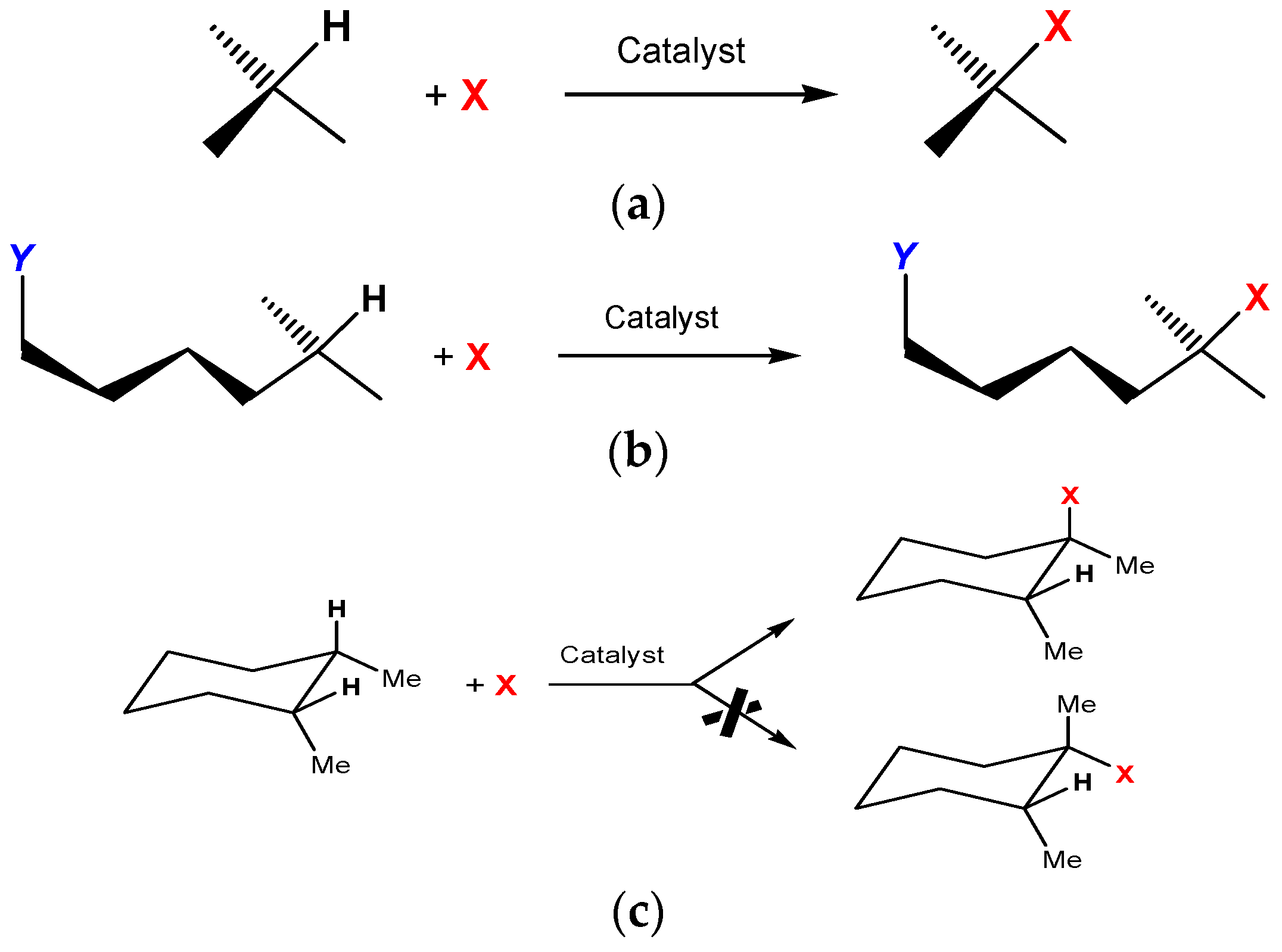
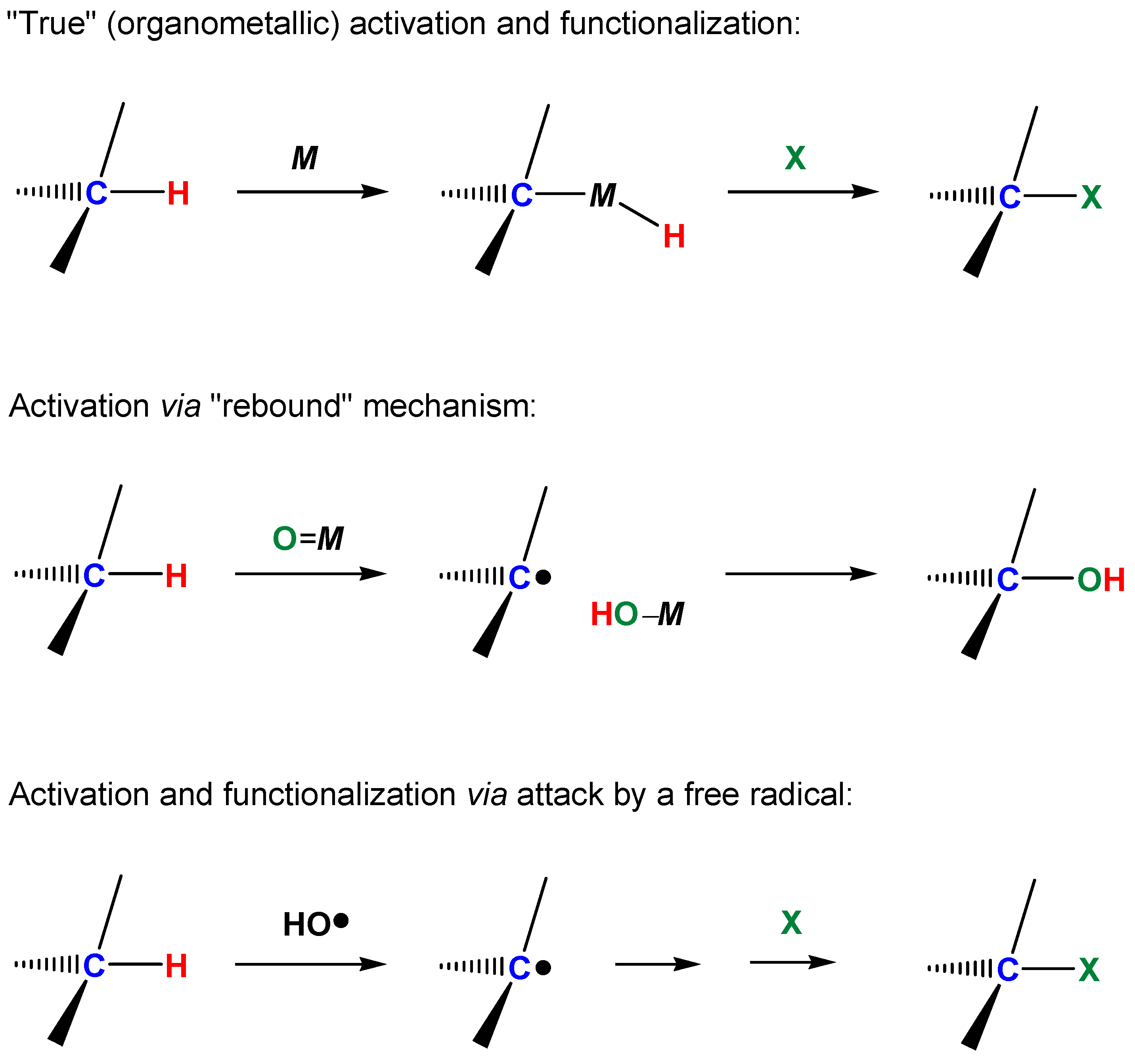
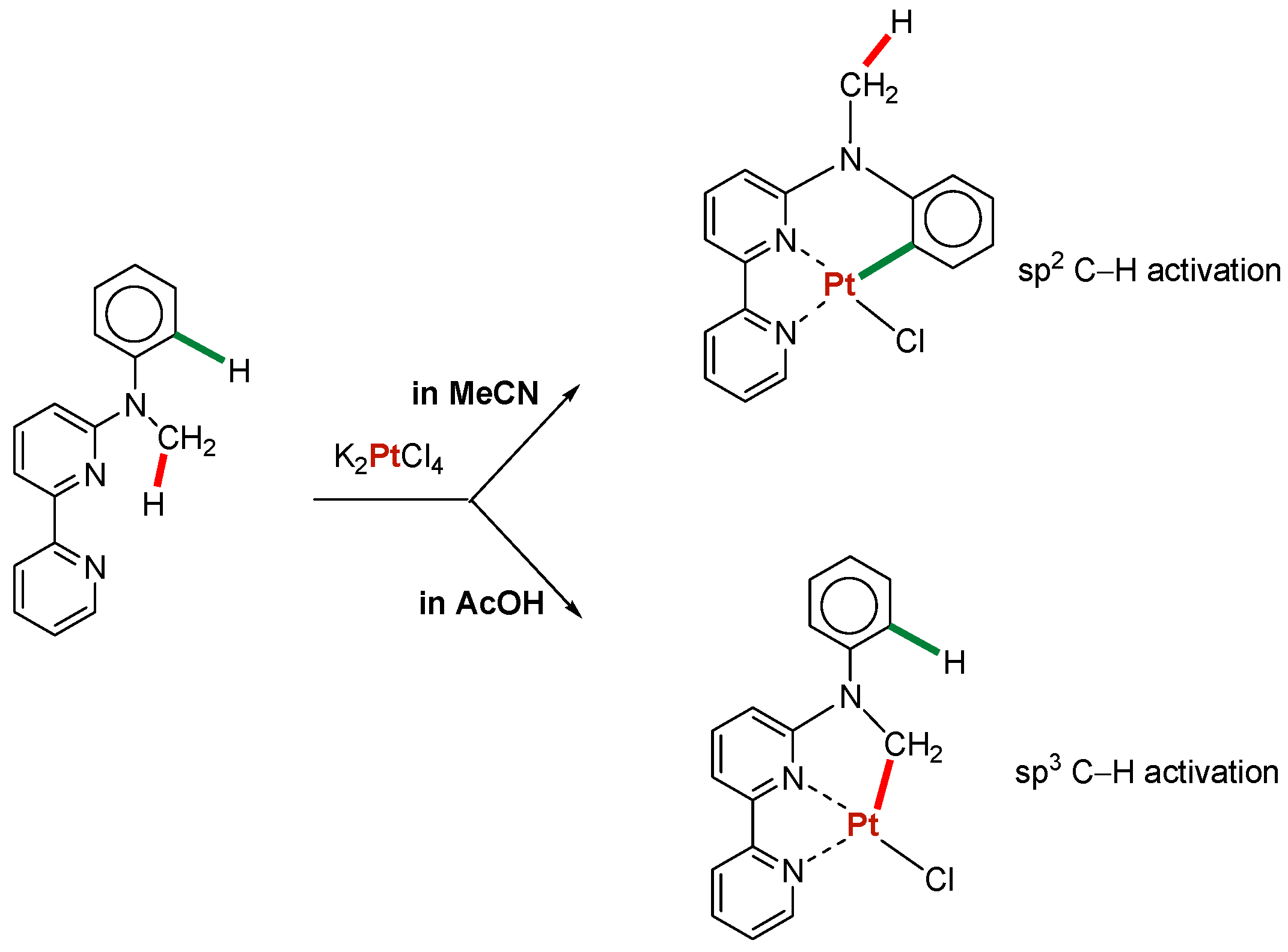
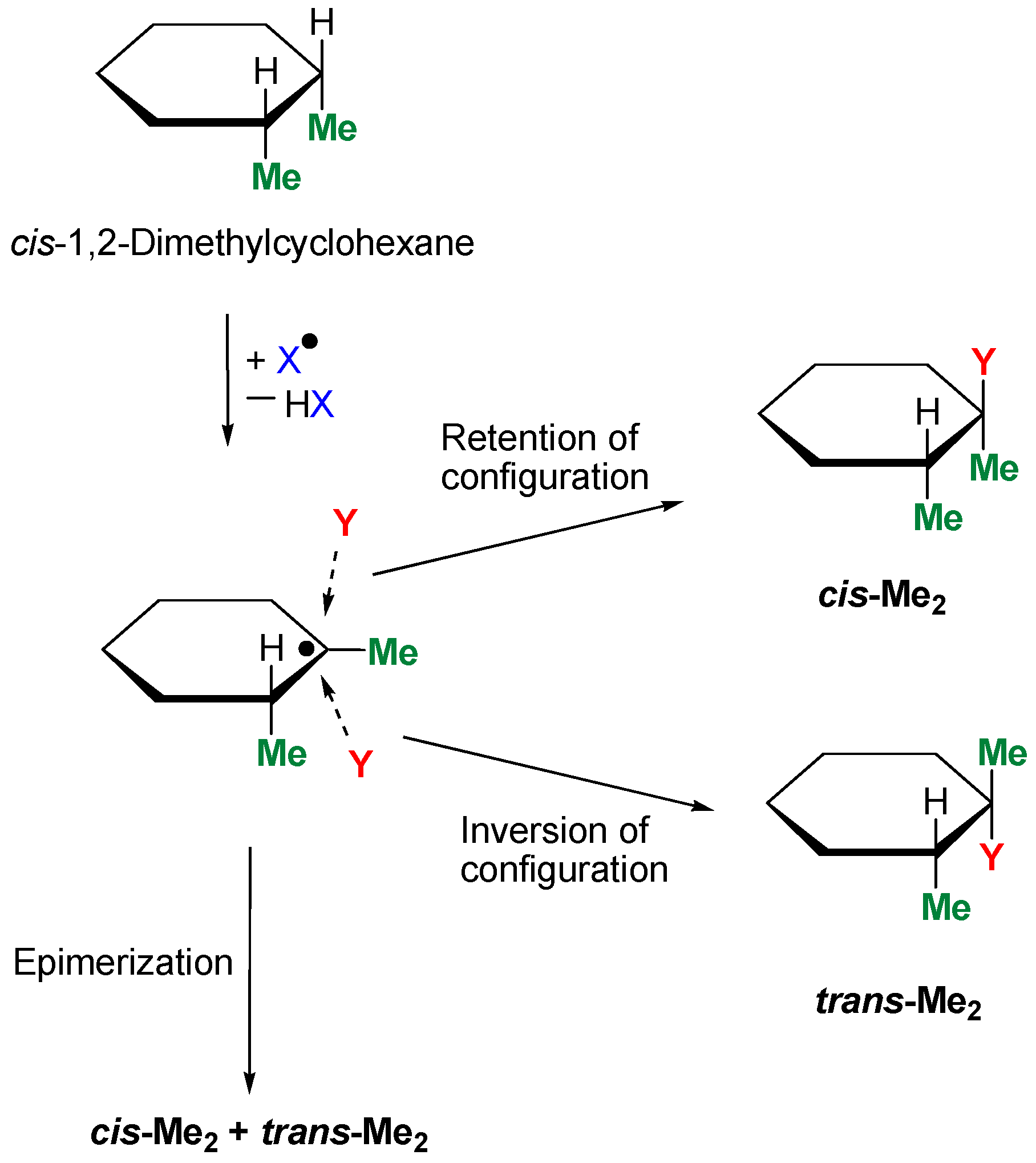
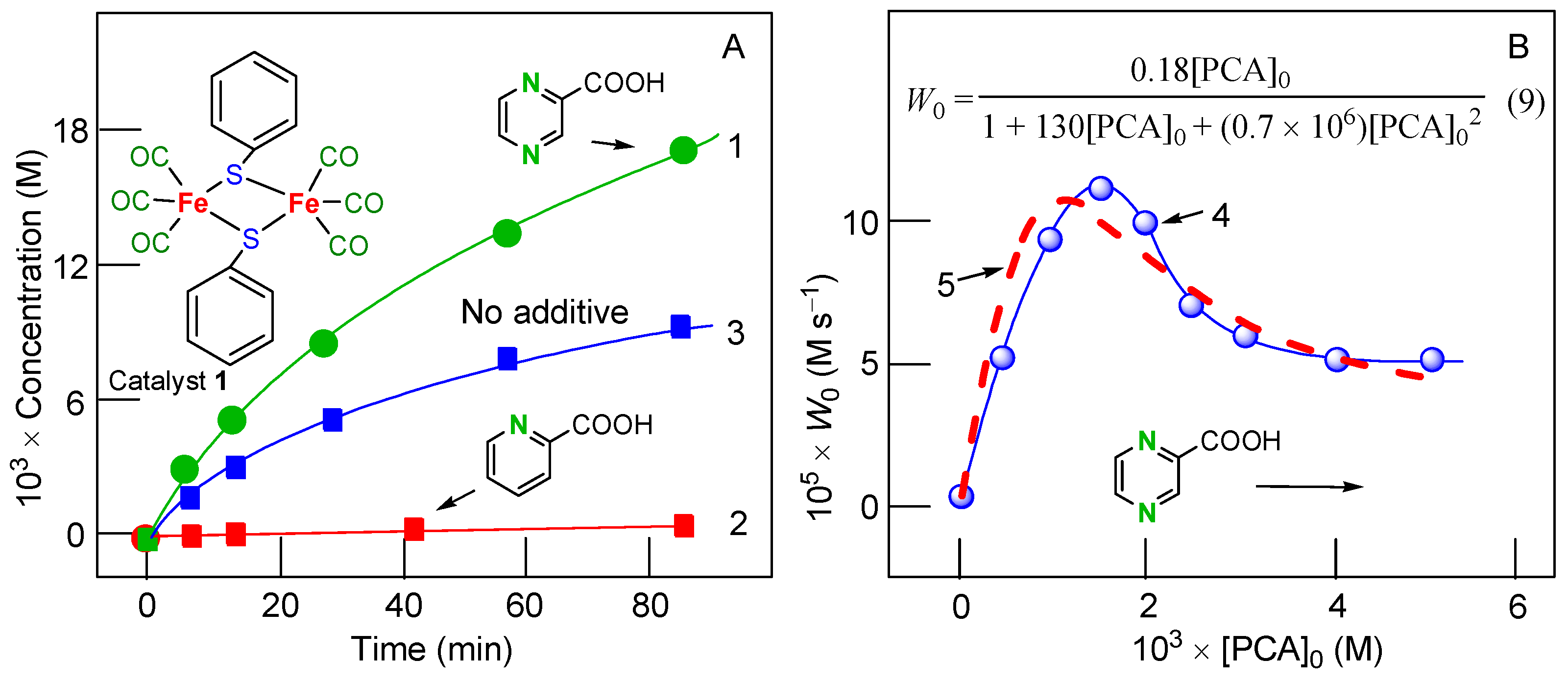
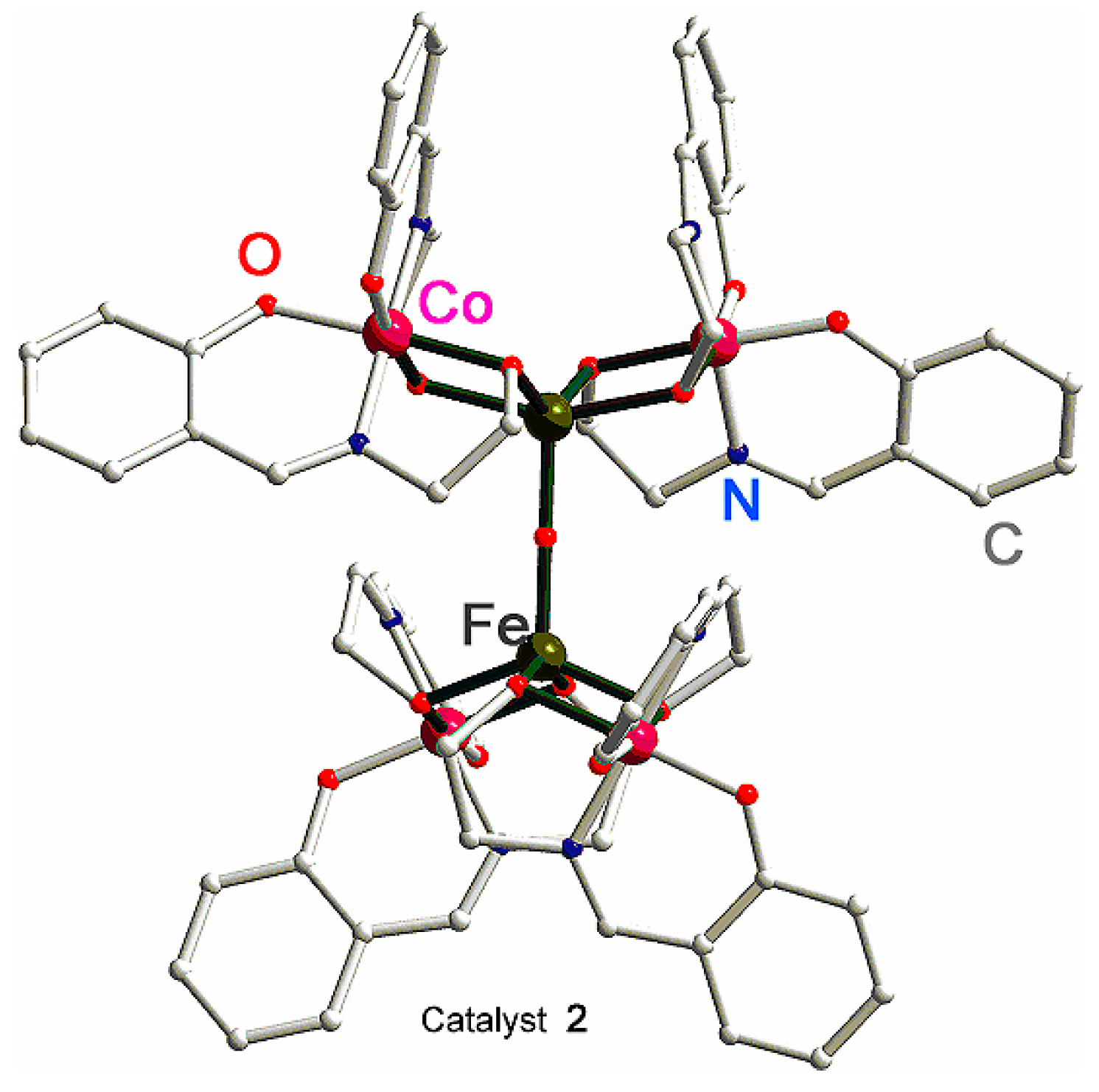
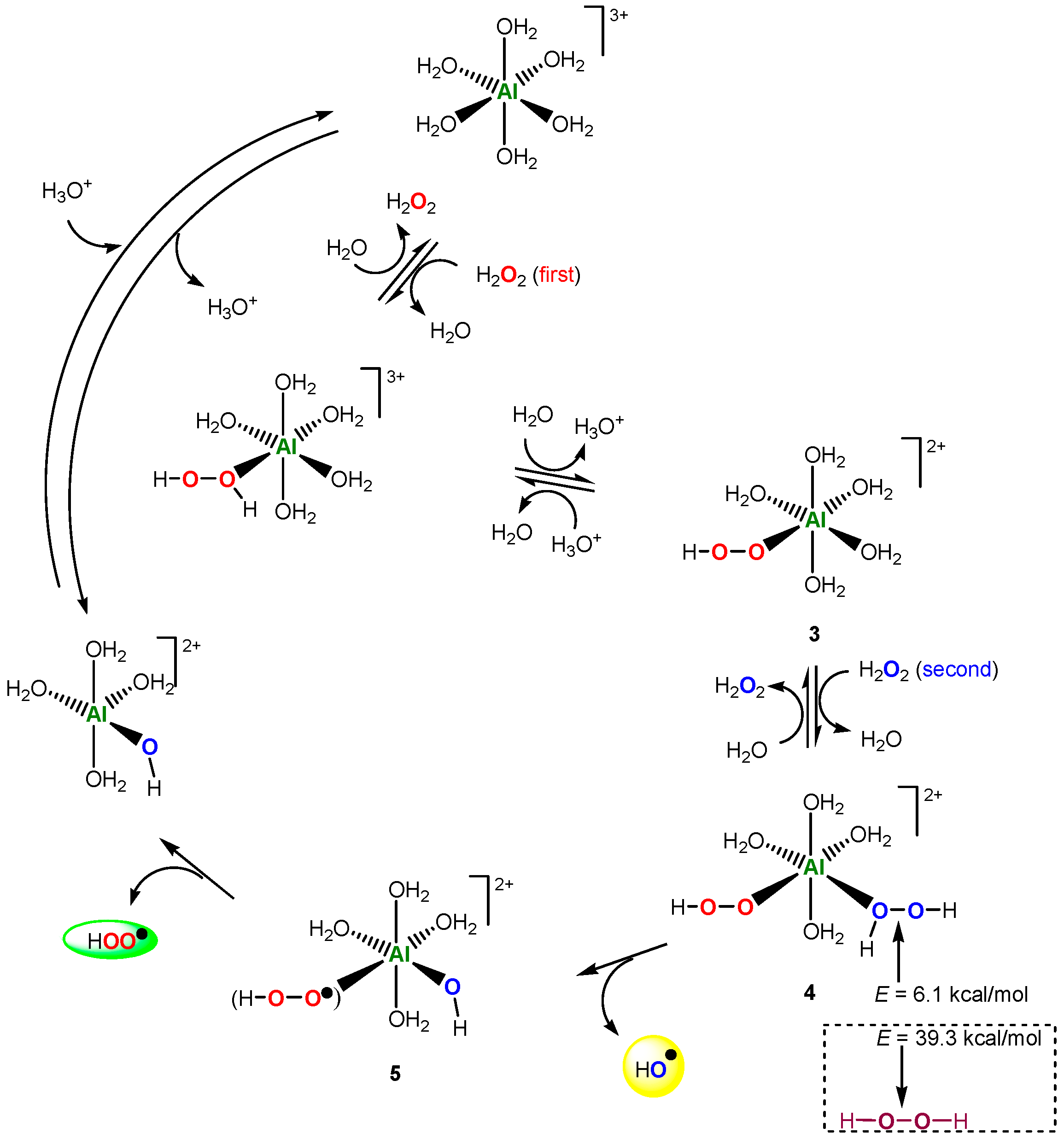
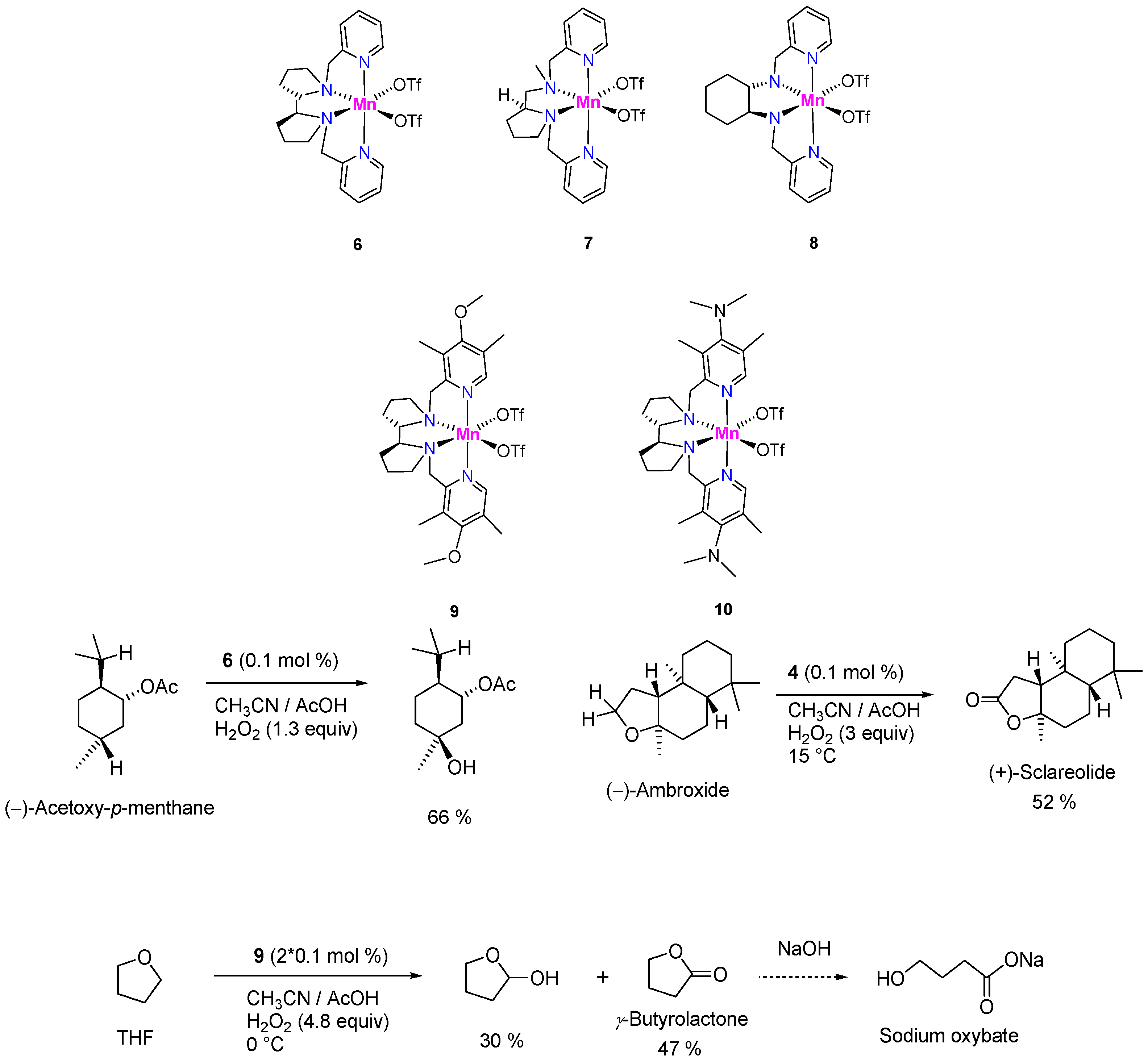
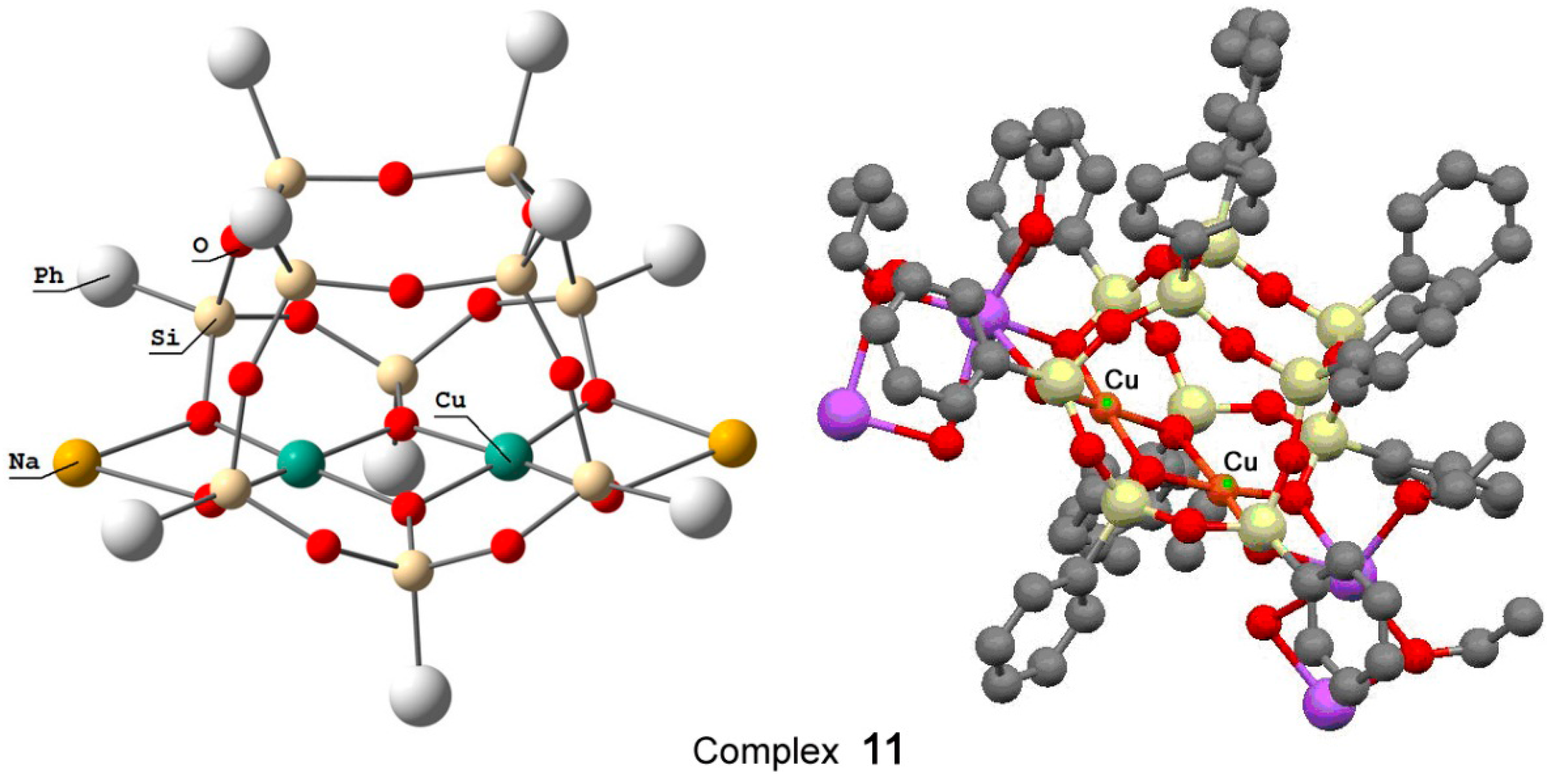

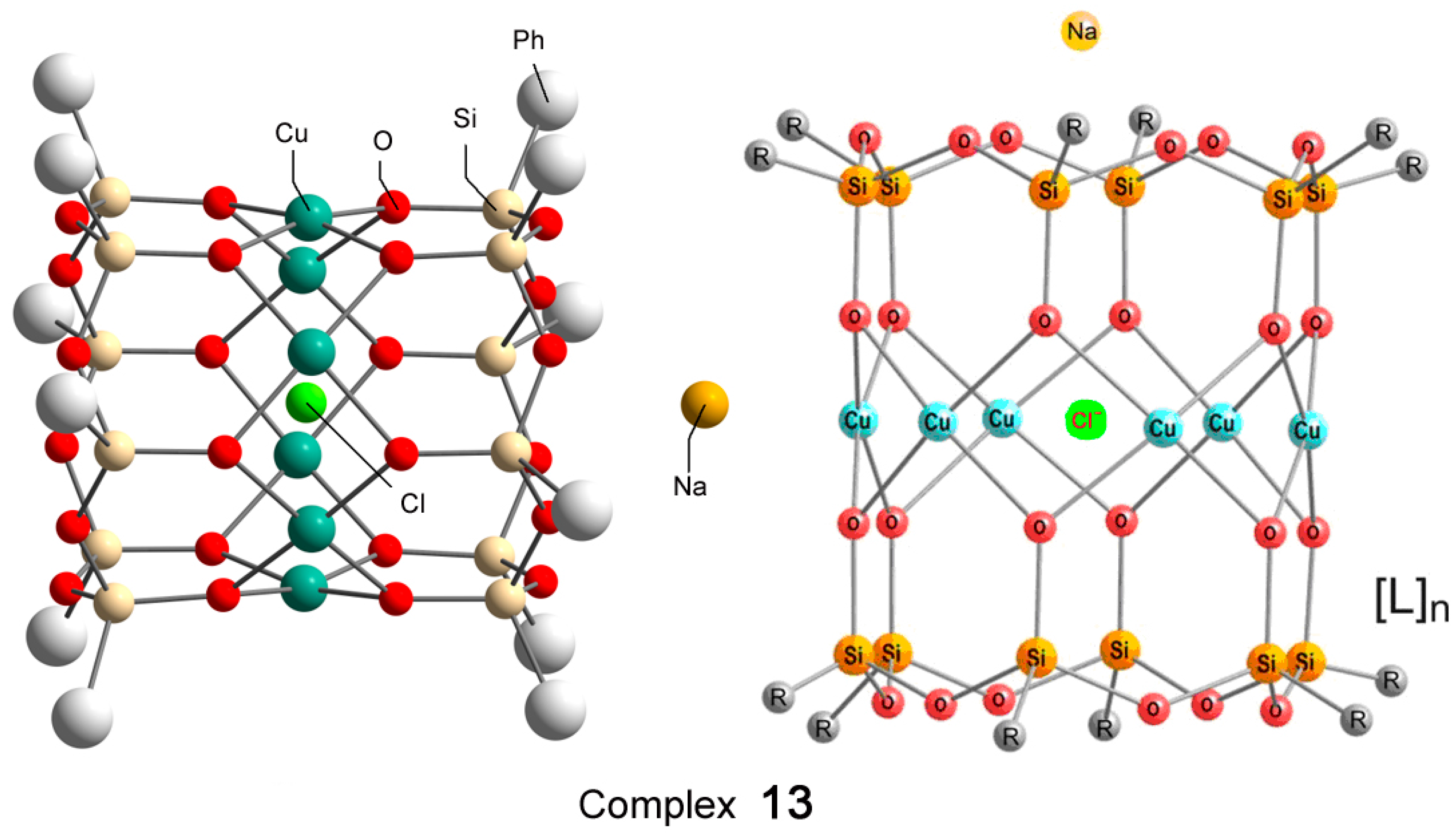
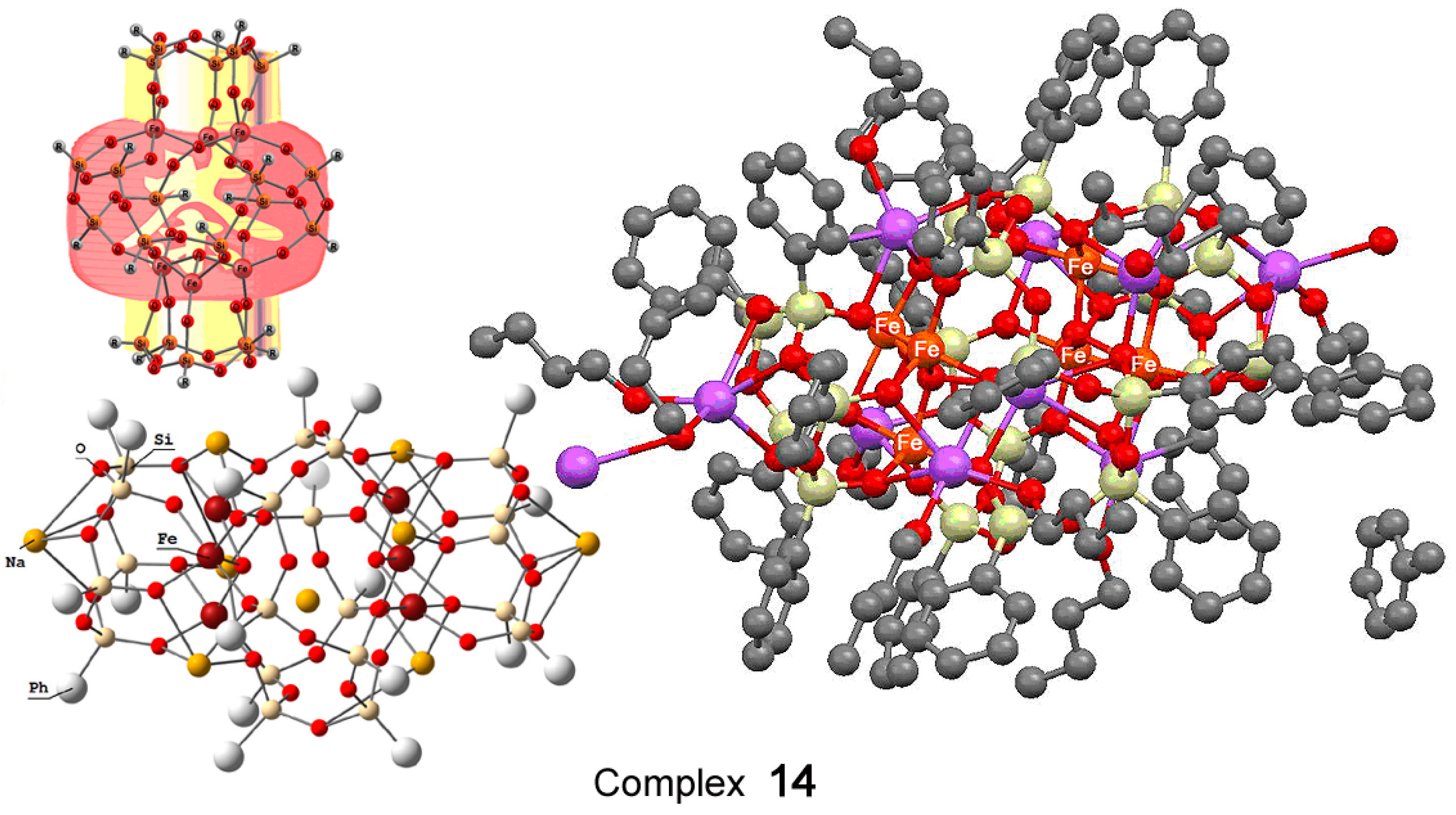
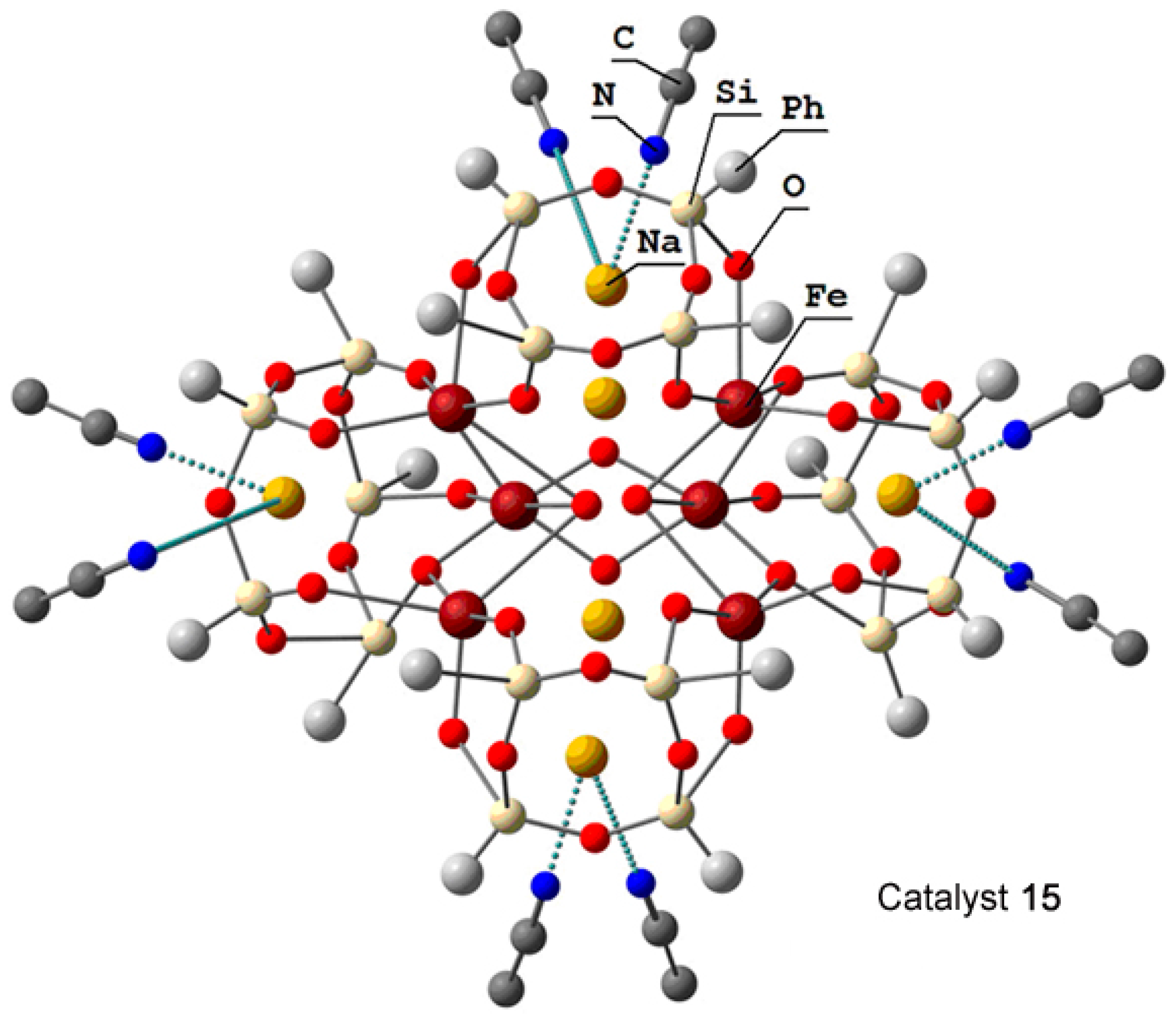
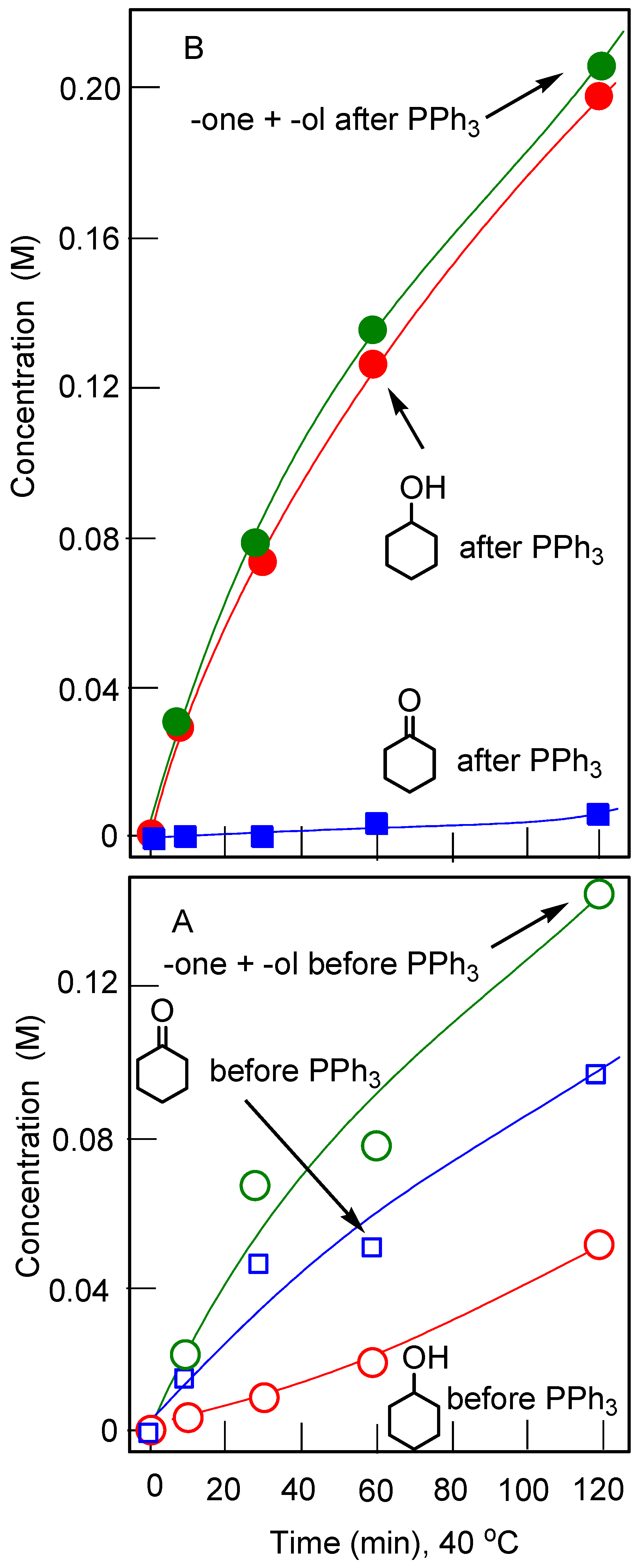
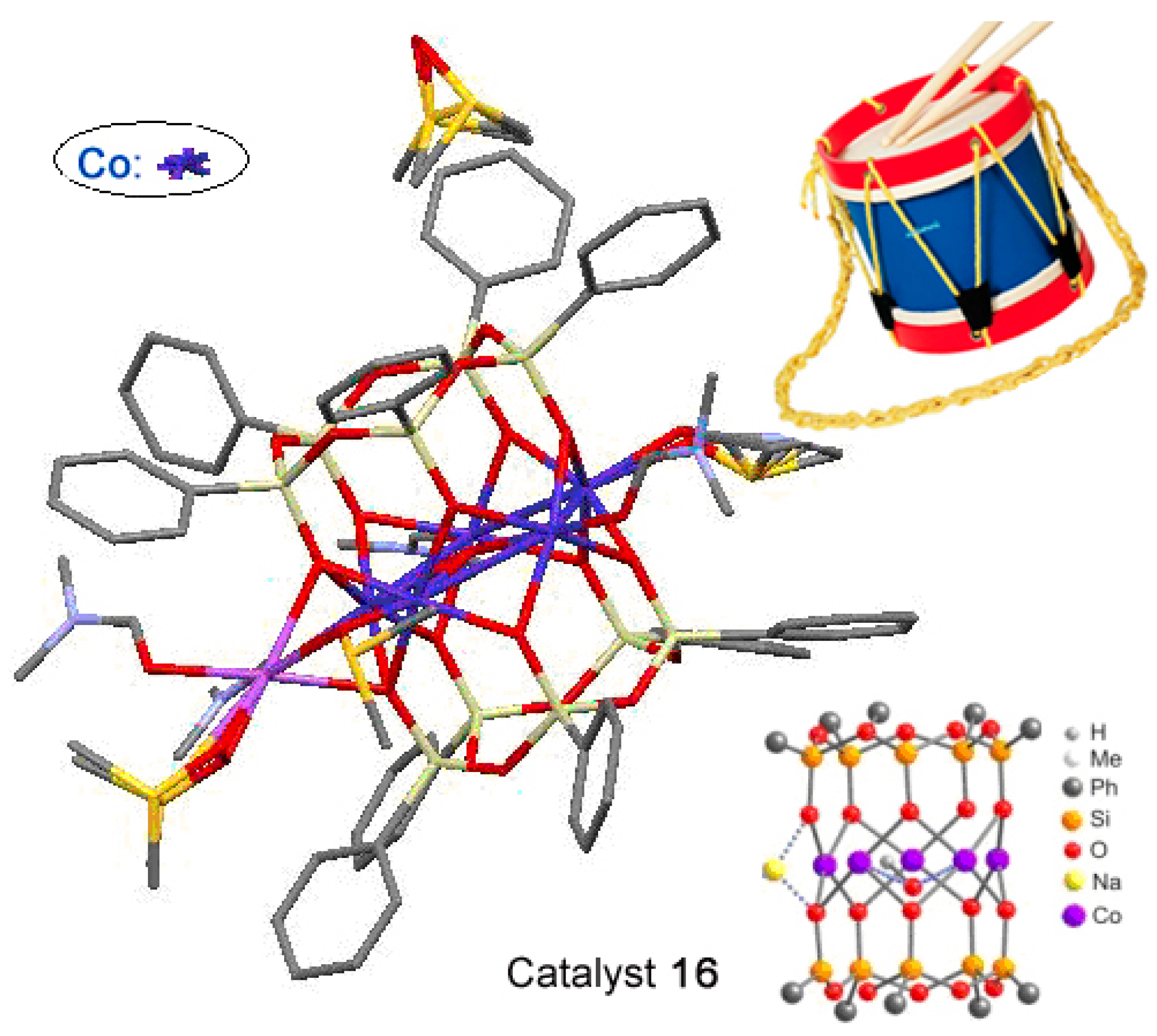
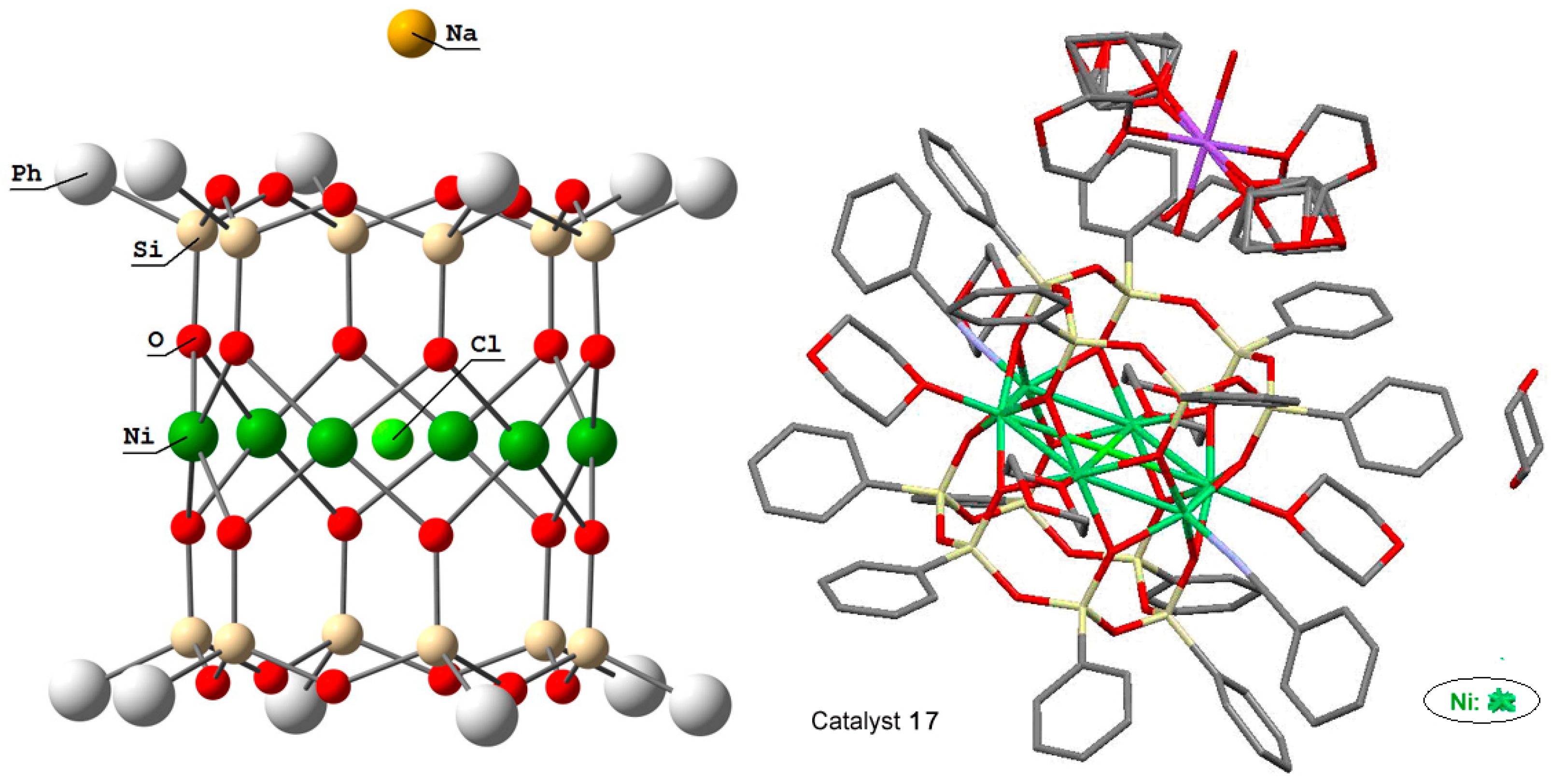

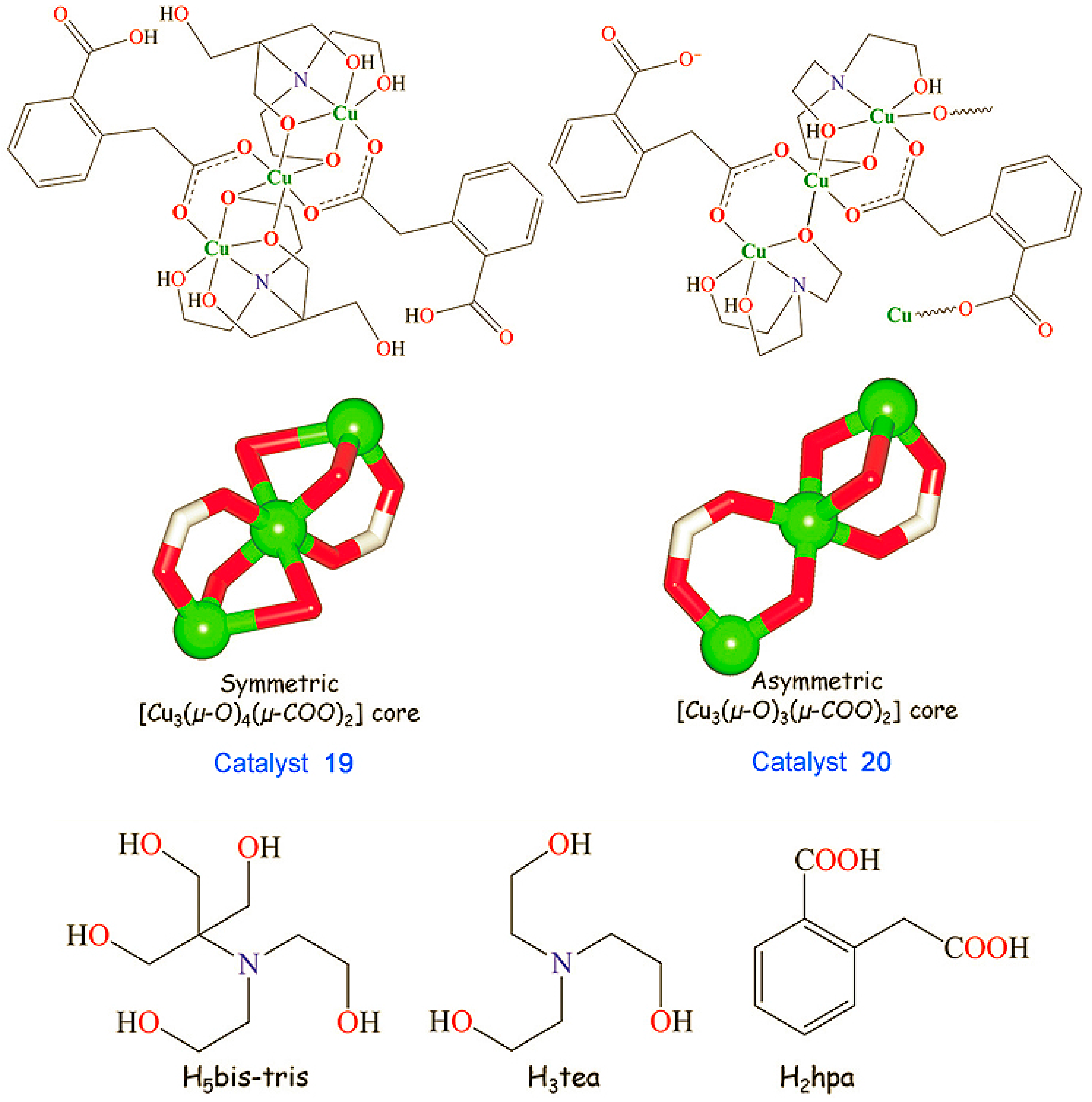
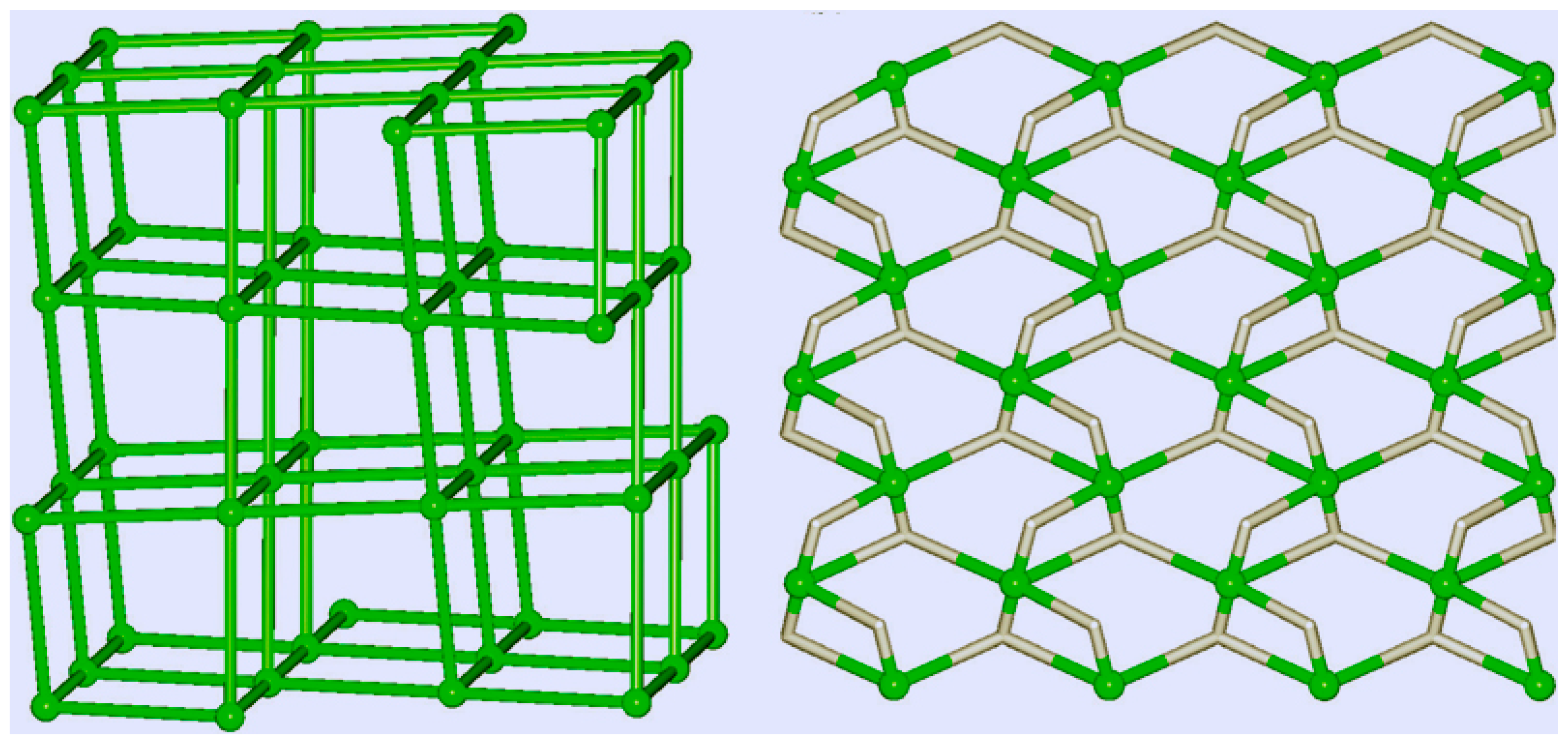
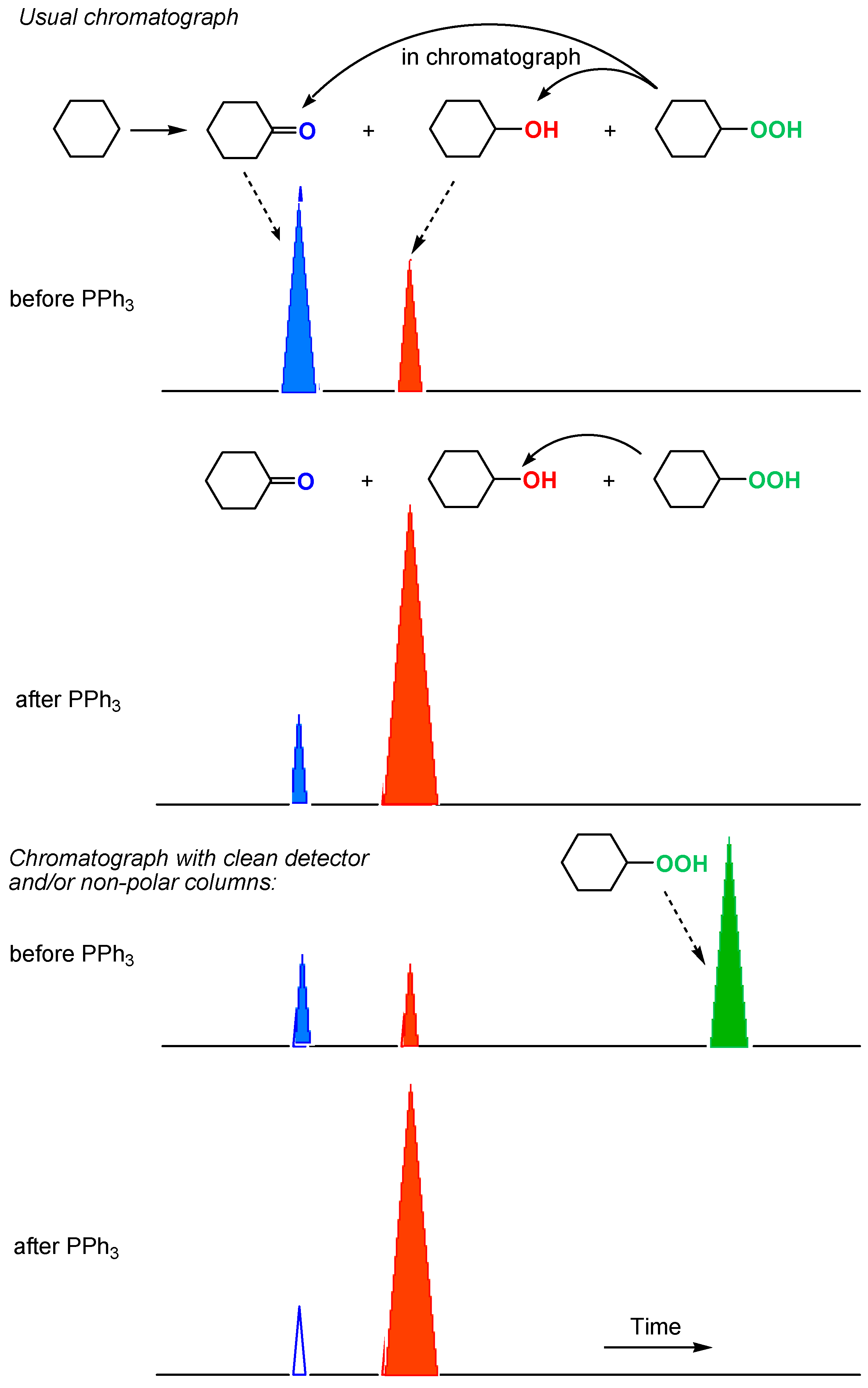
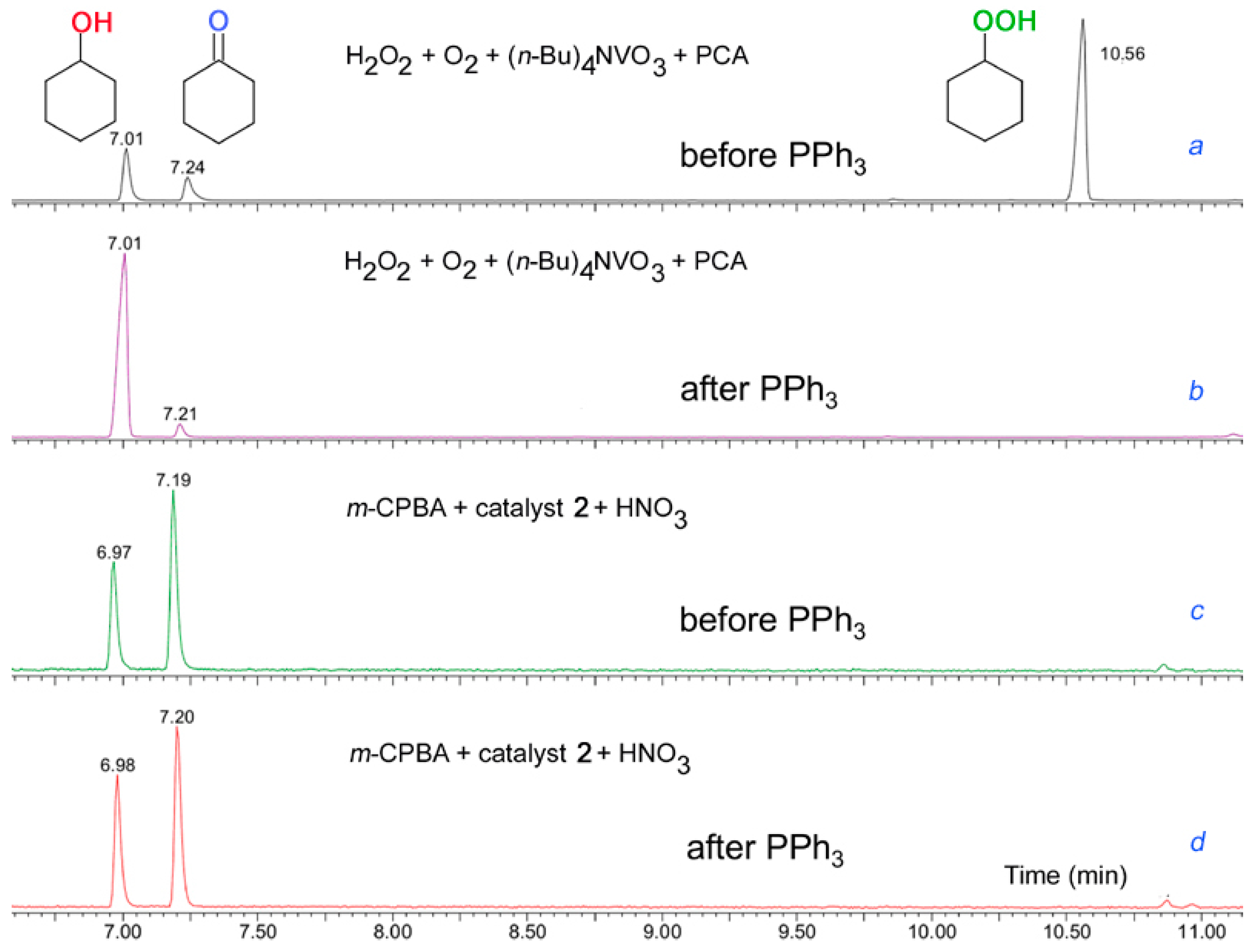
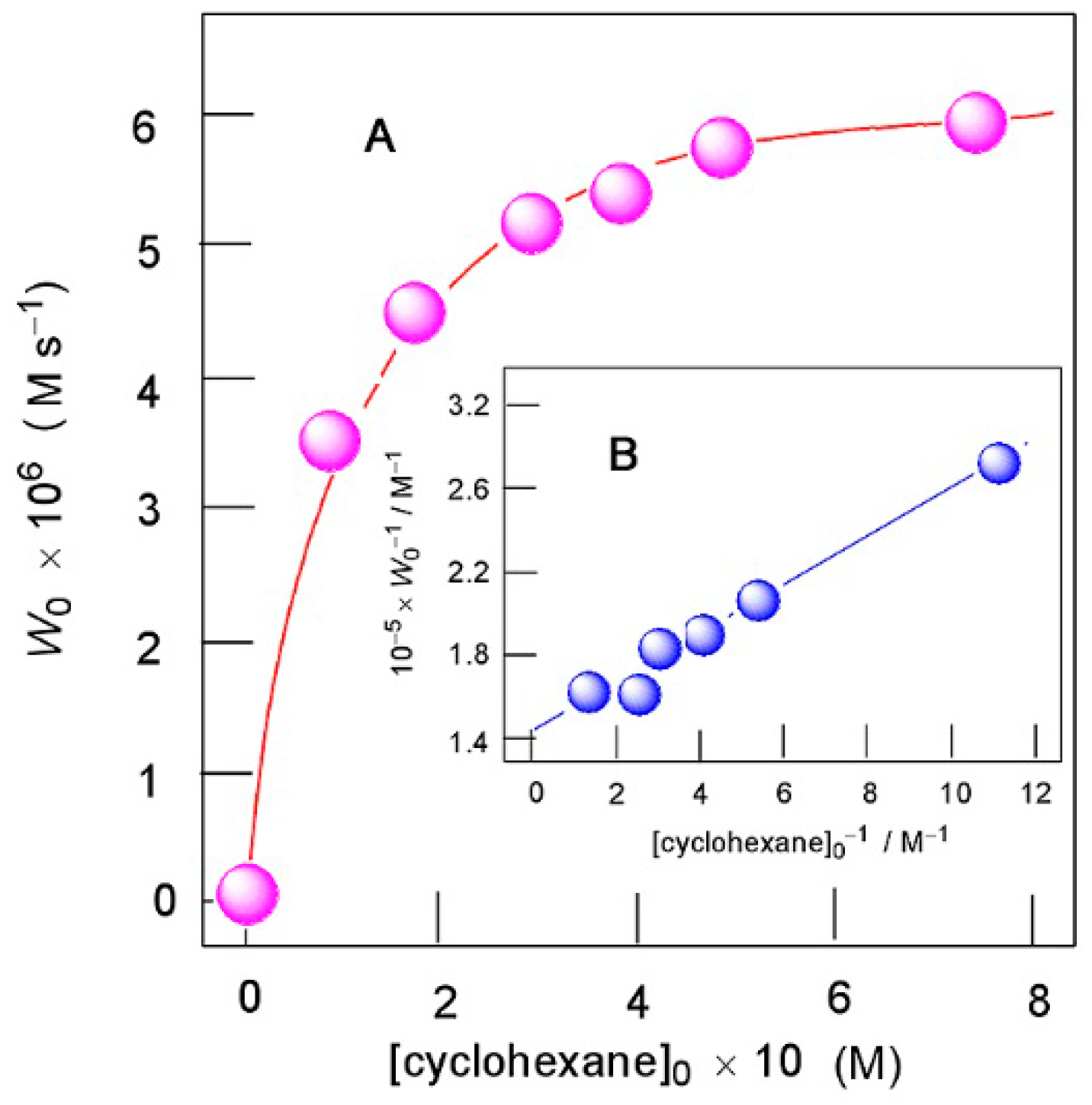
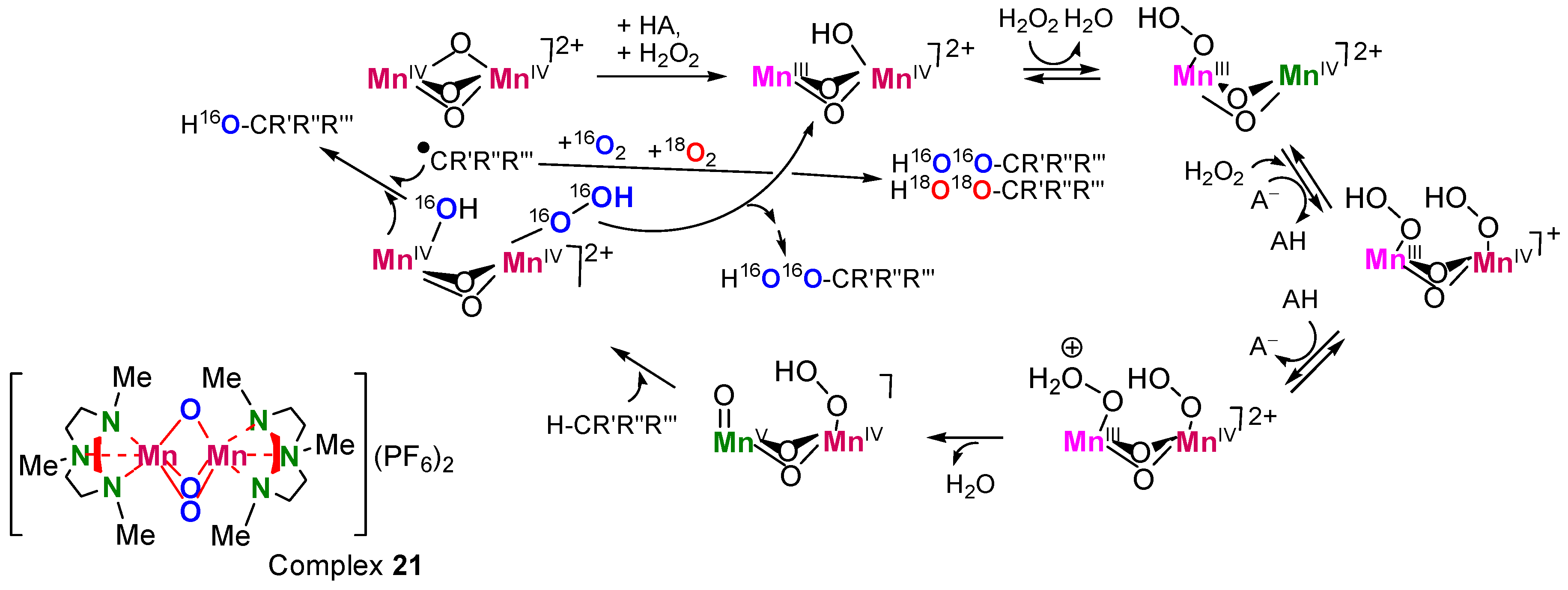

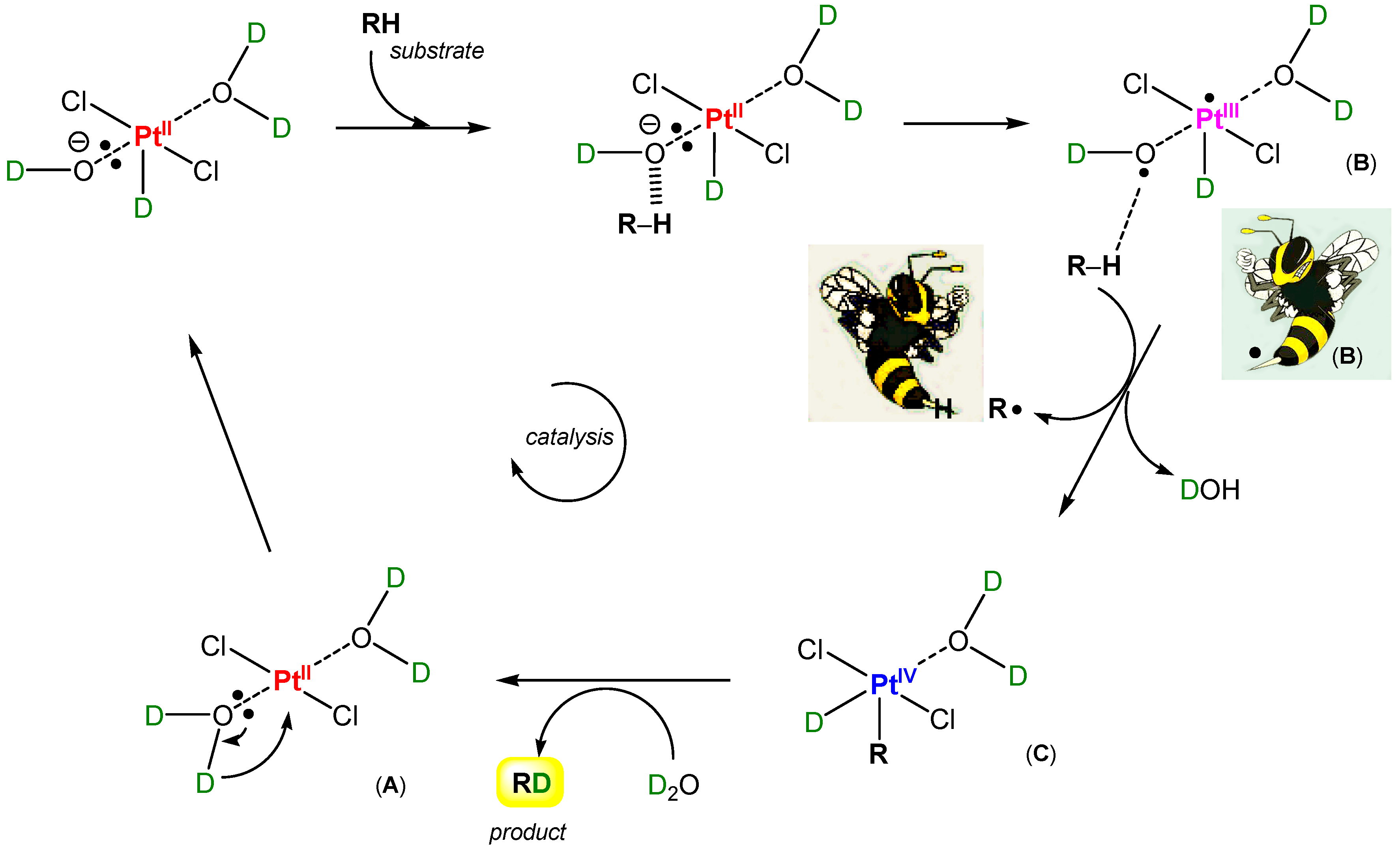

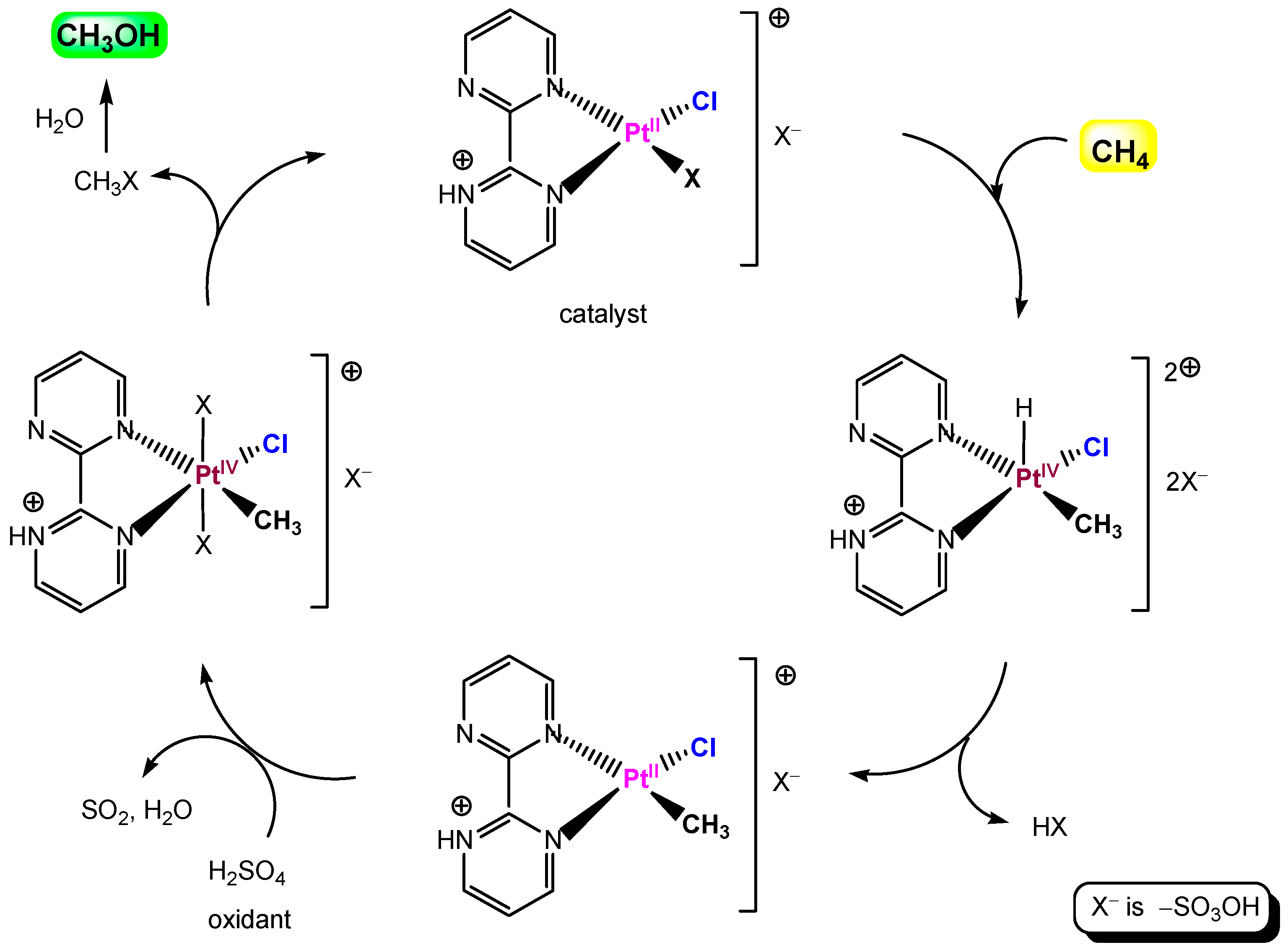
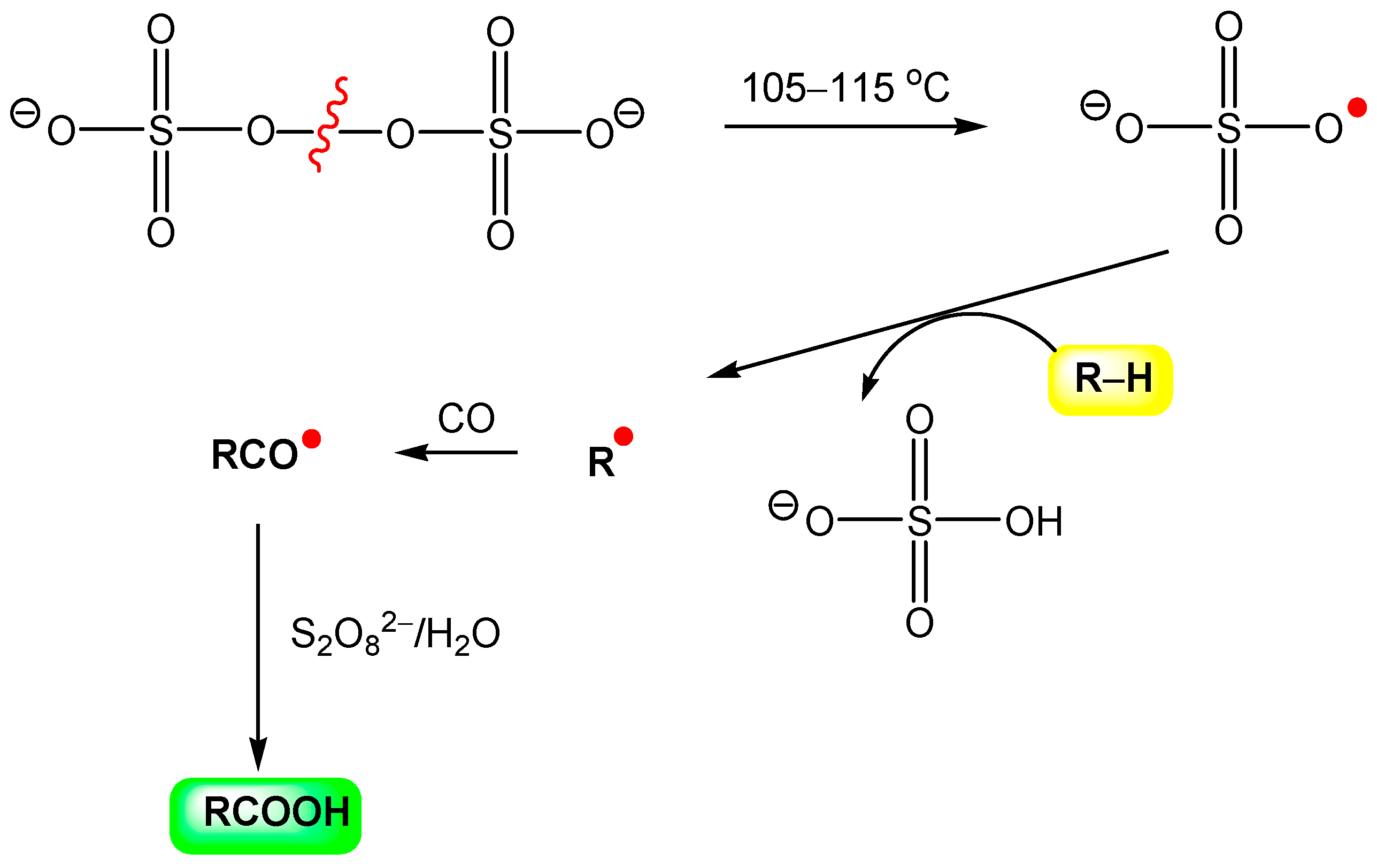
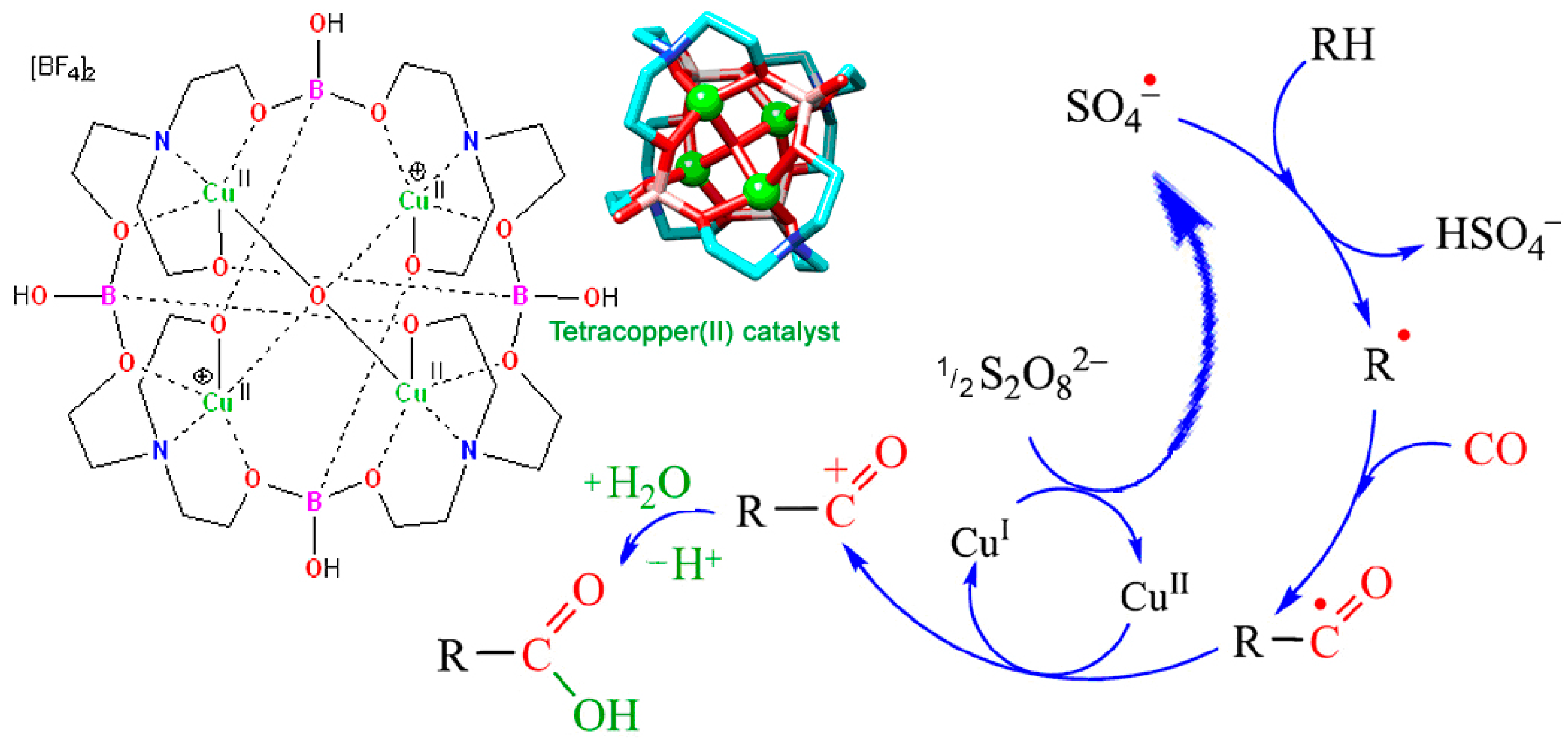
| Entry | Substrate | T (°C) | [HNO3] (M) | Time (min) | Reduction with PPh3 | t-Dimethyl-Alcohol (mM) | c-Dimethyl-Alcohol (mM) | Yield (%) | Ratio t/c |
|---|---|---|---|---|---|---|---|---|---|
| 1 b | cis-1,2-DMCH | 40 | 0 | 120 | yes | 4 | 5.7 | 7 | 0.70 |
| 2 b | cis-1,2-DMCH | 50 | 0 | 30 | yes | 4 | 5 | 6 | 0.77 |
| 3 b | cis-1,2-DMCH | 50 | 0.05 | 30 | yes | 3 | 21 | 17 | 0.13 |
| 4 b | cis-1,2-DMCH | 40 | 0.05 | 300 | yes | 3 | 15 | 13 | 0.20 |
| 5 | cis-1,2-DMCH | 40 | 0.05 | 30 | yes | 4 | 83 | 62 | 0.05 |
| 6 | cis-1,2-DMCH | 40 | 0.05 | 15 | no | 3 | 55 | 41 | 0.05 |
| 7 | cis-1,2-DMCH | 40 | 0.05 | 15 | yes | 3 | 55 | 41 | 0.05 |
| 8 | trans-1,2-DMCH | 40 | 0.05 | 15 | yes | 33 | 2 | 25 | 16 |
| 9 | cis-1,4-DMCH | 40 | 0.05 | 15 | yes | 19 | 59 | 56 | 0.32 |
| 10 | trans-1,4-DMCH | 40 | 0.05 | 15 | yes | 33 | 2 | 25 | 16 |
© 2016 by the author; licensee MDPI, Basel, Switzerland. This article is an open access article distributed under the terms and conditions of the Creative Commons by Attribution (CC-BY) license (http://creativecommons.org/licenses/by/4.0/).
Share and Cite
Shul’pin, G.B. New Trends in Oxidative Functionalization of Carbon–Hydrogen Bonds: A Review. Catalysts 2016, 6, 50. https://doi.org/10.3390/catal6040050
Shul’pin GB. New Trends in Oxidative Functionalization of Carbon–Hydrogen Bonds: A Review. Catalysts. 2016; 6(4):50. https://doi.org/10.3390/catal6040050
Chicago/Turabian StyleShul’pin, Georgiy B. 2016. "New Trends in Oxidative Functionalization of Carbon–Hydrogen Bonds: A Review" Catalysts 6, no. 4: 50. https://doi.org/10.3390/catal6040050
APA StyleShul’pin, G. B. (2016). New Trends in Oxidative Functionalization of Carbon–Hydrogen Bonds: A Review. Catalysts, 6(4), 50. https://doi.org/10.3390/catal6040050




